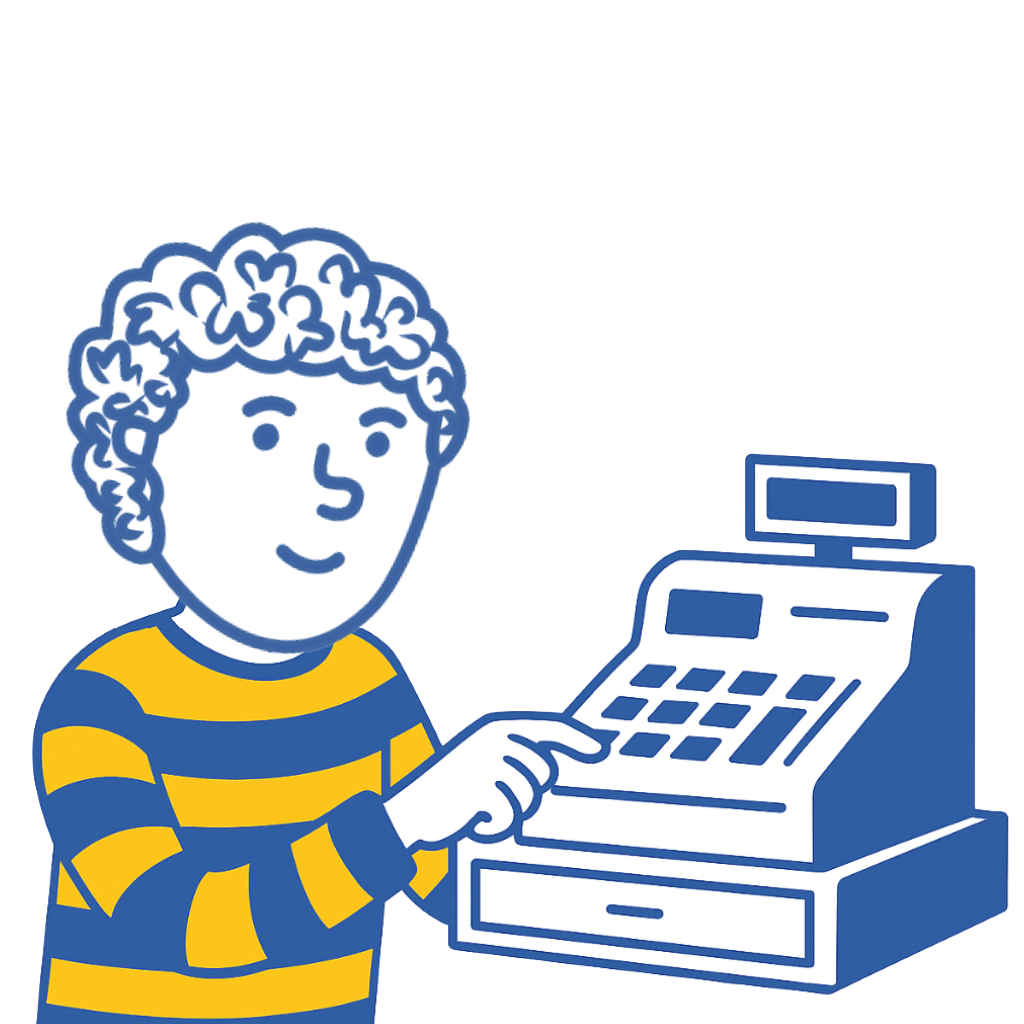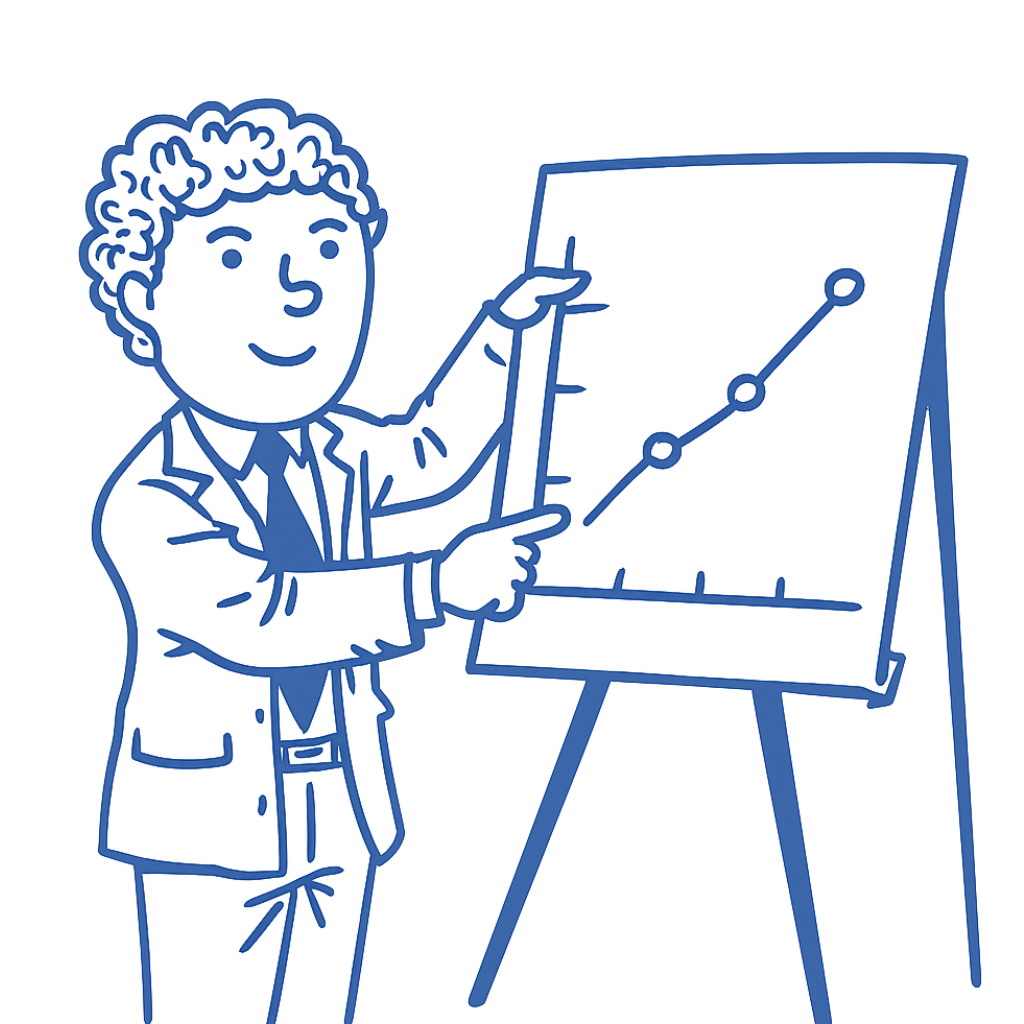Table of Contents
- Backlinks remain the baseline KPI, but quality (relevance, authority, traffic) matters far more than quantity.
- Track 12 impact areas: from referral traffic and branded search to direct traffic and owned audience growth.
- Ahrefs, GA4, and Talkwalker are critical tools for evaluating both SEO and brand-related outcomes.
- Unlinked brand mentions and social traffic often signal PR success beyond traditional SEO value.
- Long-term gains in site authority and conversions depend on consistent, high-quality digital PR campaigns.
Digital PR has a problem.
According to our most recent report on the State of Digital PR, the problem is measuring impact.
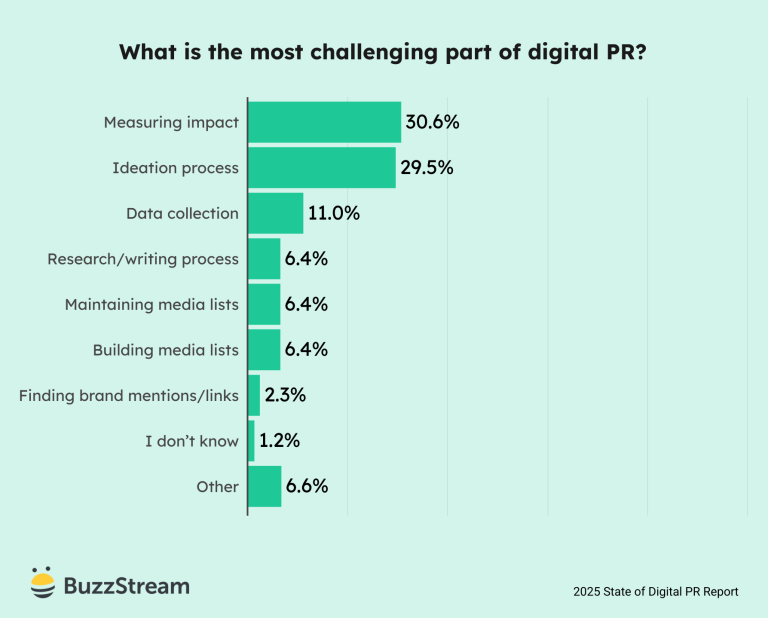
There are many ways to measure digital PR impact.
There may be too many, and focusing on the wrong ones can sometimes lessen the impact that you are having.
Not every campaign touches every metric.
So, in this post, I will show you everything that digital PR touches, what to focus on when measuring impact, when to use each metric, and why.
- Backlinks are the baseline metric that most clients and stakeholders expect
- Referral traffic shows you traffic from your links
- Unlinked brand mentions are more valuable than some SEOs think
- Site authority metrics like DR/DA can be misleading but provide a baseline
- Page level traffic can tie ranking growth to digital PR campaigns
- Sitewide organic traffic tells the macro story
- Branded keywords/traffic can tie together traditional and digital PR
- Direct traffic can help measure brand awareness
- Social media traffic is becoming more and more common in digital PR performance tracking
- Offline mentions can come when a piece goes really big or really local
- Owned audience growth is another big metric to track in 2025
- Conversions/leads are the ultimate goal of most marketing campaigns
1. Backlinks
Why? Backlinks are the most traditional way to measure digital PR performance. It’s what most clients and stakeholders expect as a baseline.
The links typically drive all other metrics.
Let’s dig into that.
What Does it Impact?
Backlinks can positively impact site authority, organic traffic, and rankings.
Backlinks can also impact referral traffic, as you’ll see in the next section.
These are the typical types of links that you’ll see tracked:
- Follow links – (Sometimes called “dofollow” links.) The standard backlink. Google crawls these to get from one site to another.
- Nofollow links – Links marked with “nofollow,” according to Google, get ignored. (Though some disagree.)
- Syndicated links – Links appearing within syndicated content, which Google views as duplicate content.
- Referring domains – (Sometimes called linking root domains.) This is the number of domains sending links back to a site.
- Total backlinks – This is the total number of links (and may contain multiple links from the same domain).
When we asked digital PRs how they measure success, they mentioned quality links as the best way to measure success:
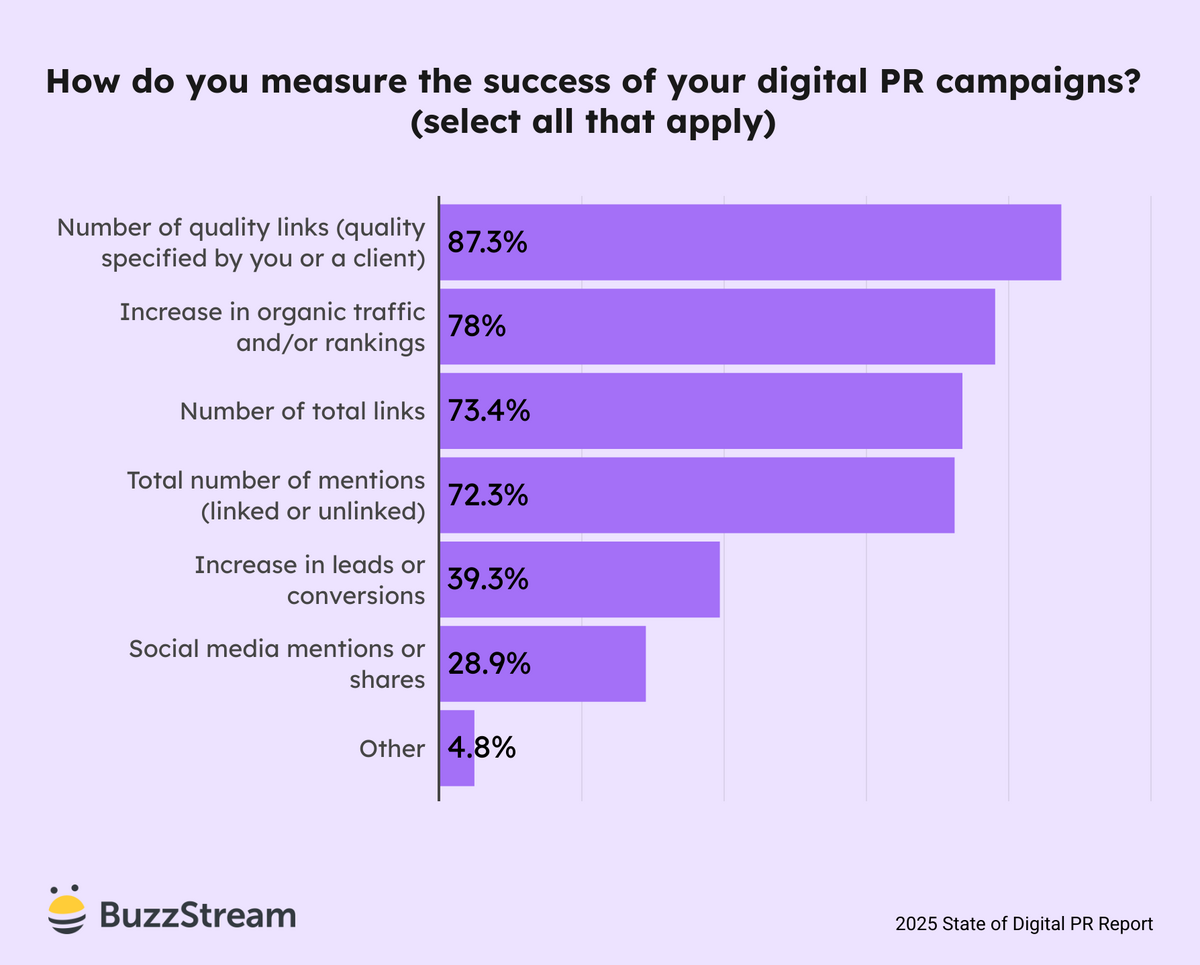
For me, quality links are way more important than the pure quantity.
It’s enticing to deliver a report that includes every link achieved, but quality is essential if you are looking to focus on real value for a client or stakeholder.
However, the definition of “quality” gets a bit complicated.
In our post on quality links, we define them with these characteristics:
- High site authority
- High page authority
- High organic traffic
- Low spam score
- High site relevancy
- High page relevancy
- Low number of outbound links
- Few clicks from homepage
- Normal link acquisition velocity
- Display E-E-A-T & helpful content
- Unobtrusive ads
That’s a lot of factors, but you can see from our survey that PRs say they evaluate a link’s quality in the same ways:
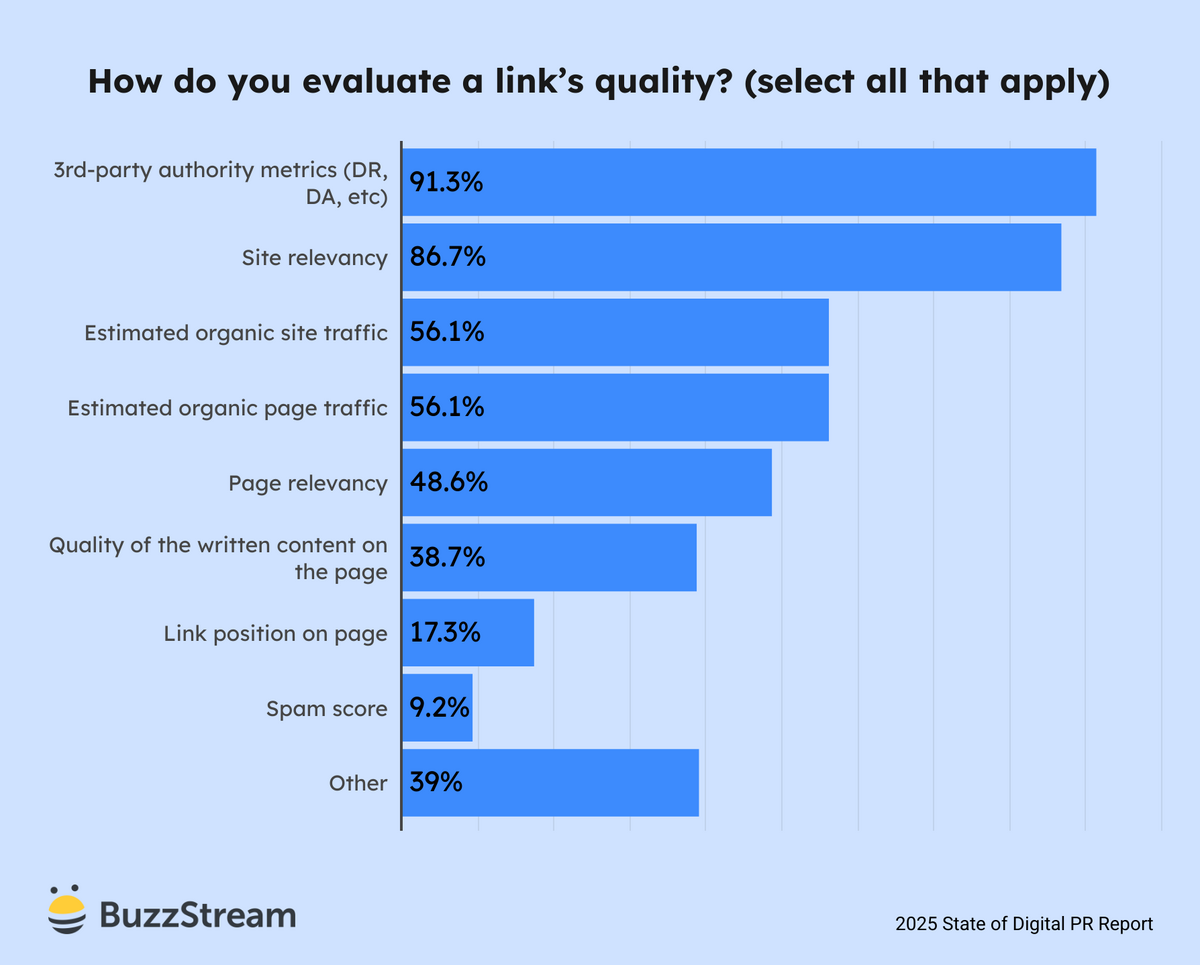
So, let’s talk about how to measure the impact of backlinks.
How to Track Impact?
A tool like Ahrefs’ Site Explorer is the easiest way to track backlinks.
To find the total backlinks, simply enter your URL and look at the default number in the top left.
You can also toggle to “All backlinks.”
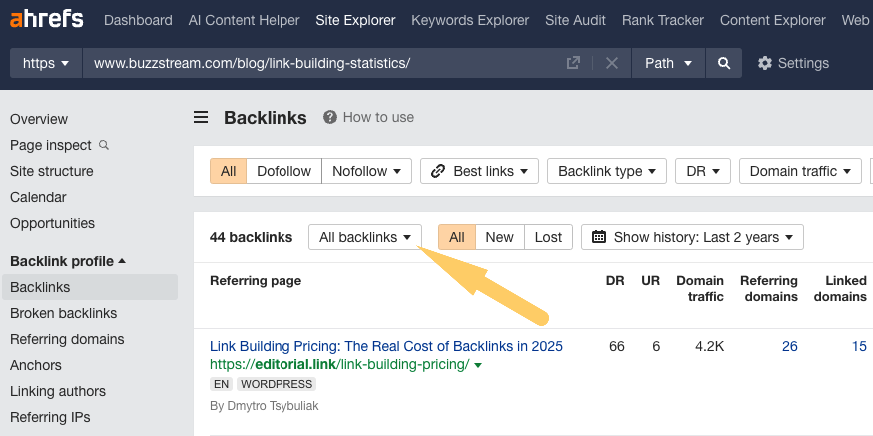
To find the number of follow links vs nofollow, look for the Nofollow tag.

You can also toggle the Nofollow filter:
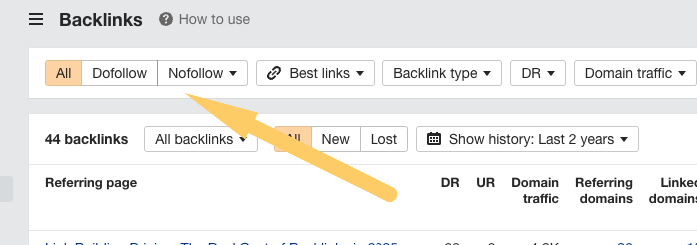
To find syndicated links, you need to do some manual digging.
Look for duplicate content, titles, and text surrounding the anchor.
For instance, here’s what four syndicated links look like from a Preply post:
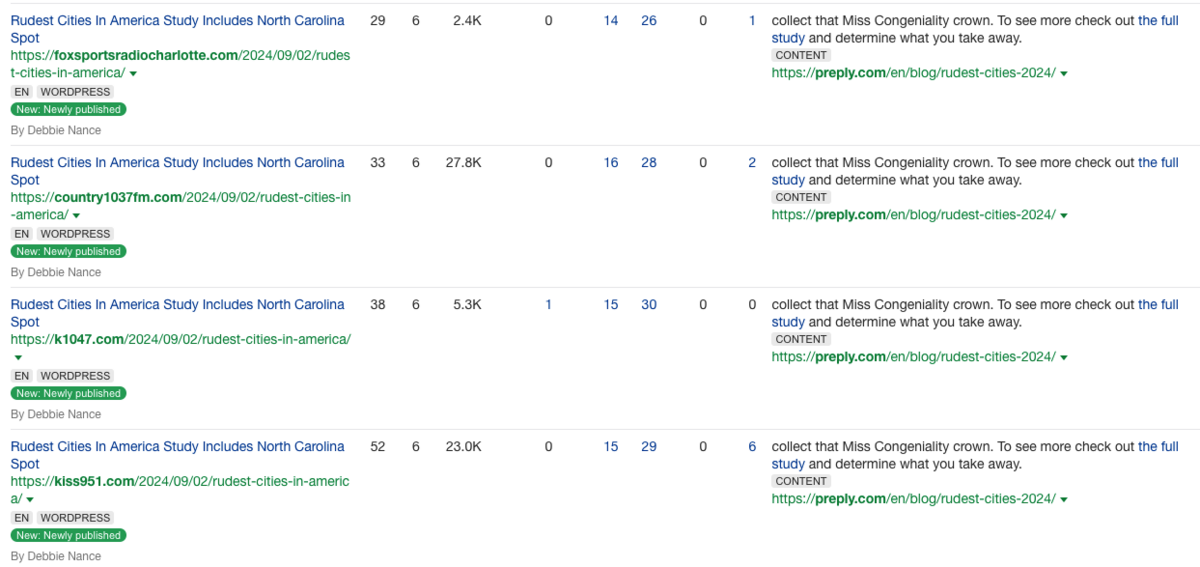
As you can see, all three have the same exact text surrounding the link and the same post title.
These are all part of a syndicated network of news sites in North Carolina.
To find the number of “quality” backlinks, use the Site Explorer’s Best Links feature.
Their tool gives a shortcut for some of the factors I mentioned when measuring “quality,” like traffic and site authority.
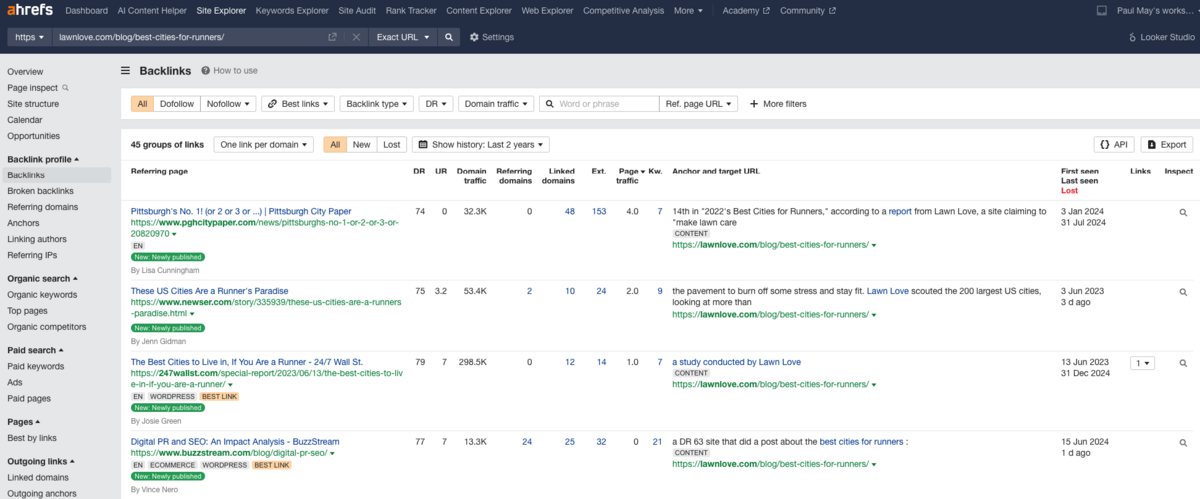
In the screenshot above I’m looking at Lawn Love’s Best Cities for Runners raw referring domain count.
I could look at the unique backlinks by grouping them into one link per domain.
Then, I like to use Ahrefs’ Best Links filter to show the “best” links, which you’ll see I’ve set only to display Dofollow links with a DR above 75 and traffic about 10,000.
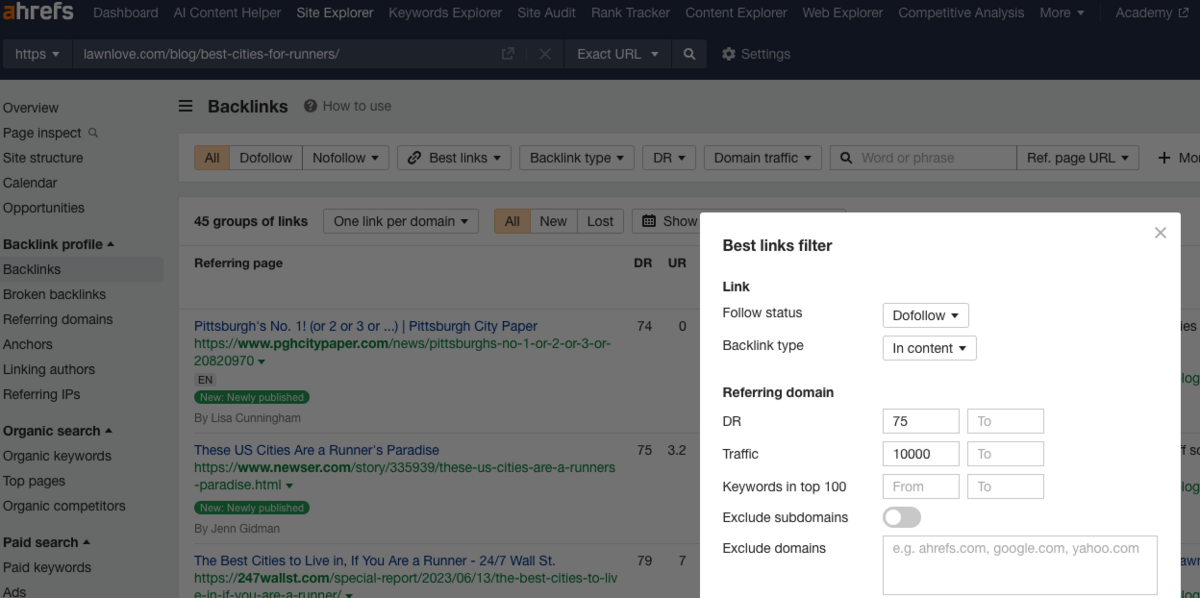
The list jumps from 45 to 7:
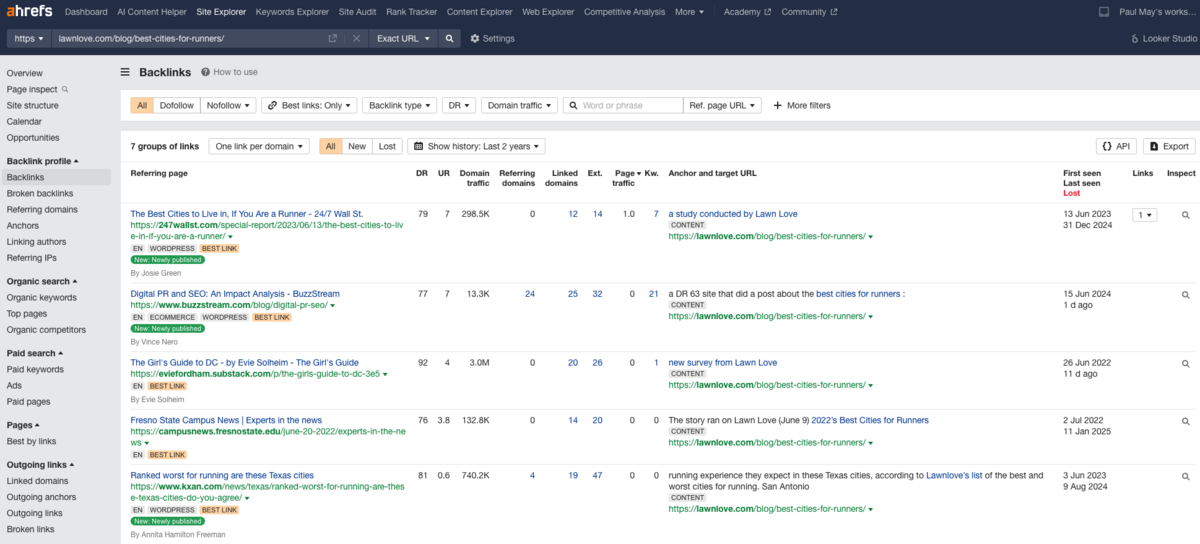
So, this post has seven high-quality links.
How Long Until You See Impact?
In my experience, backlinks can take about 6 months to impact a site.
Backlinks come in as quickly as crawlers can crawl them, but you rarely see an overnight impact on authority, traffic, and rankings.
One directive I’ve always followed is that it’s better to get your content featured in prominent sections of a site vs. buried deep within it.
For example, this link from SERoundtable for our State of Digital PR campaign was discovered on the day it came out:

In our State of Digital PR survey, about half of our respondents felt it takes 3-6 months to see measurable results.
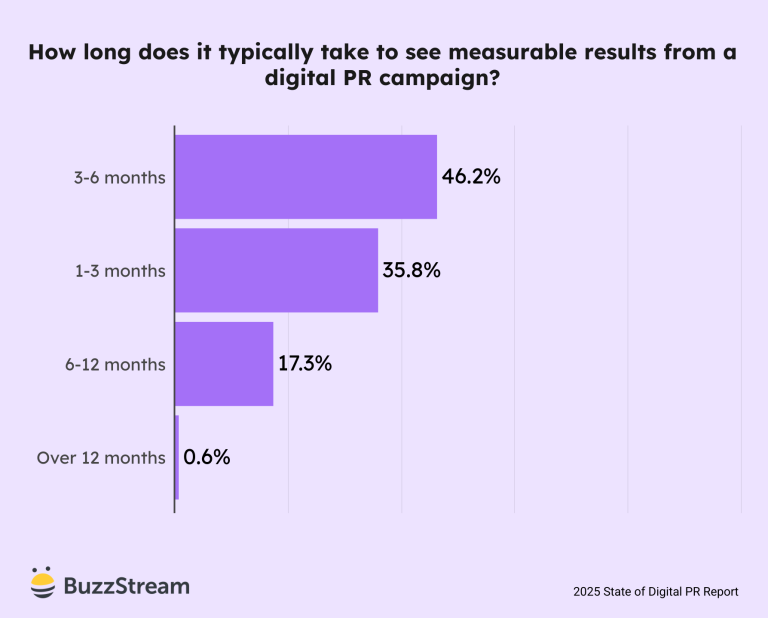
Of course, “measurable” is the keyword here.
Verdict: Focus on backlink quality over quantity. Set your definition for “quality” and stick to it.
OK – that’s one big baseline metric for measuring digital PR. Let’s get into some others.
2. Referral Traffic
Why? Referral traffic shows which sites are sending traffic to your site. If your campaign lands considerable coverage from a major publication, you’ll typically see a bump in referral traffic.
Referral traffic is an under-appreciated success metric from digital PR. It is one of the most direct ways to see the impact of your PR efforts.
What Does it Impact?
Referral traffic impacts site visits, which can lead to conversions.
Keep in mind, though, that digital PR links or links from news sites typically lead to lower referral traffic numbers. Traffic spikes when the story drops and then fizzles out.
This is because news sites (where most PRs play) cycle through stories frequently.
The longer-term referral traffic comes when you can get links placed on pages that have search volume or are highly visible on a website.
For instance, a Backlinko page that sends significant referral traffic to our site is from a page that ranks for “link building tools.”
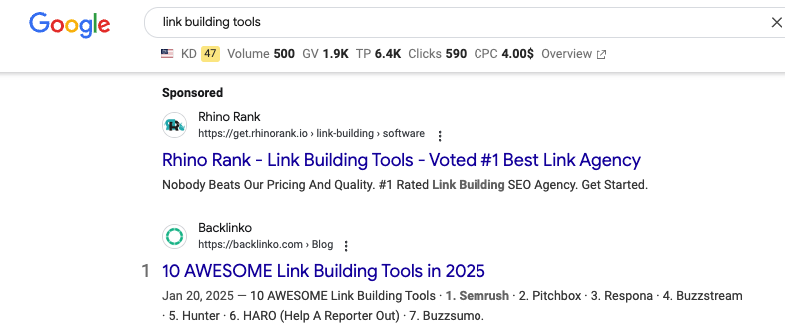
Whereas, if I were to get a link on USA Today, it provides value from a link equity standpoint and brand exposure, but won’t provide much long-term referral traffic.
How to Track Impact?
Using Google Analytics, under the Acquisition tab, I can see that about 4% of our traffic has come from Referrals in the past 12 months.
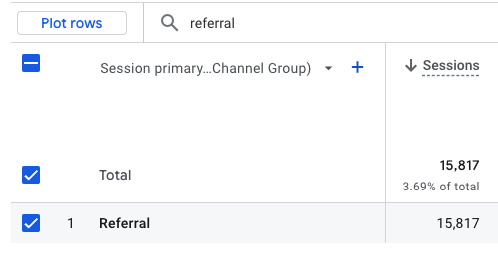
Then, I can use the traffic source as a secondary dimension.
(Unfortunately, unlike Universal Analytics, you can’t see referral traffic at the URL level—only the domain level.)
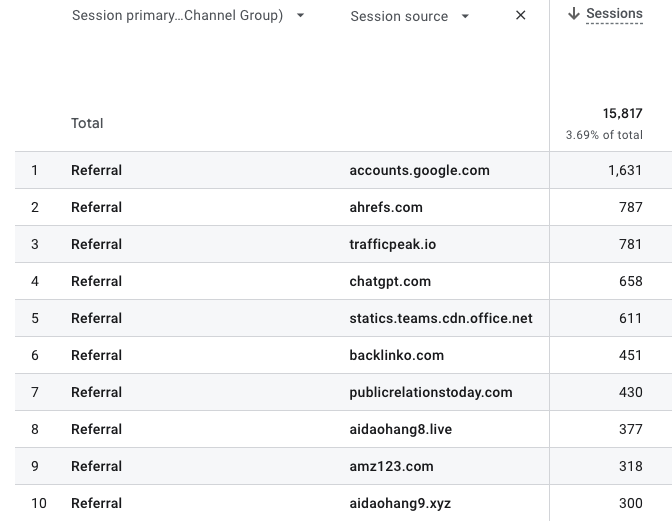
Our sixth-best referral traffic driver is backlinko.com. A quick search on Ahrefs’ Site Explorer shows me the link driving that traffic.

So I can attribute traffic directly to this link.
How Long Until You See Impact?
Typically, referral traffic appears immediately after you get the link, but it depends on the link’s placement on the site and how likely a user is to click on it.
If you get a link from a news site, you’ll usually see the referral traffic impact immediately afterward, which will die down after a few days.
If you score a link on the post that eventually ranks for a keyword, you’ll start seeing traffic as soon as that post ranks.
Verdict – Referral traffic is a visible, quantifiable impact of a link to your site.
3. Unlinked Brand Mentions
Why? To the traditional PR, brand mentions are one of, if not the main KPI for any campaign.
I think all digital PRs should report on unlinked brand mentions.
On the one hand, a mention can sometimes change into a linked one.
But, on a non-SEO level, we are moving towards a brand-first industry. Many of the recent studies show how users interact with brands they know.
What Does it Impact?
From an SEO perspective, unlinked brand mentions may have less, if any, impact at all. So, with digital PR, unlinked brand mentions are still a bit of a gray area.
In most cases, they are treated separately:
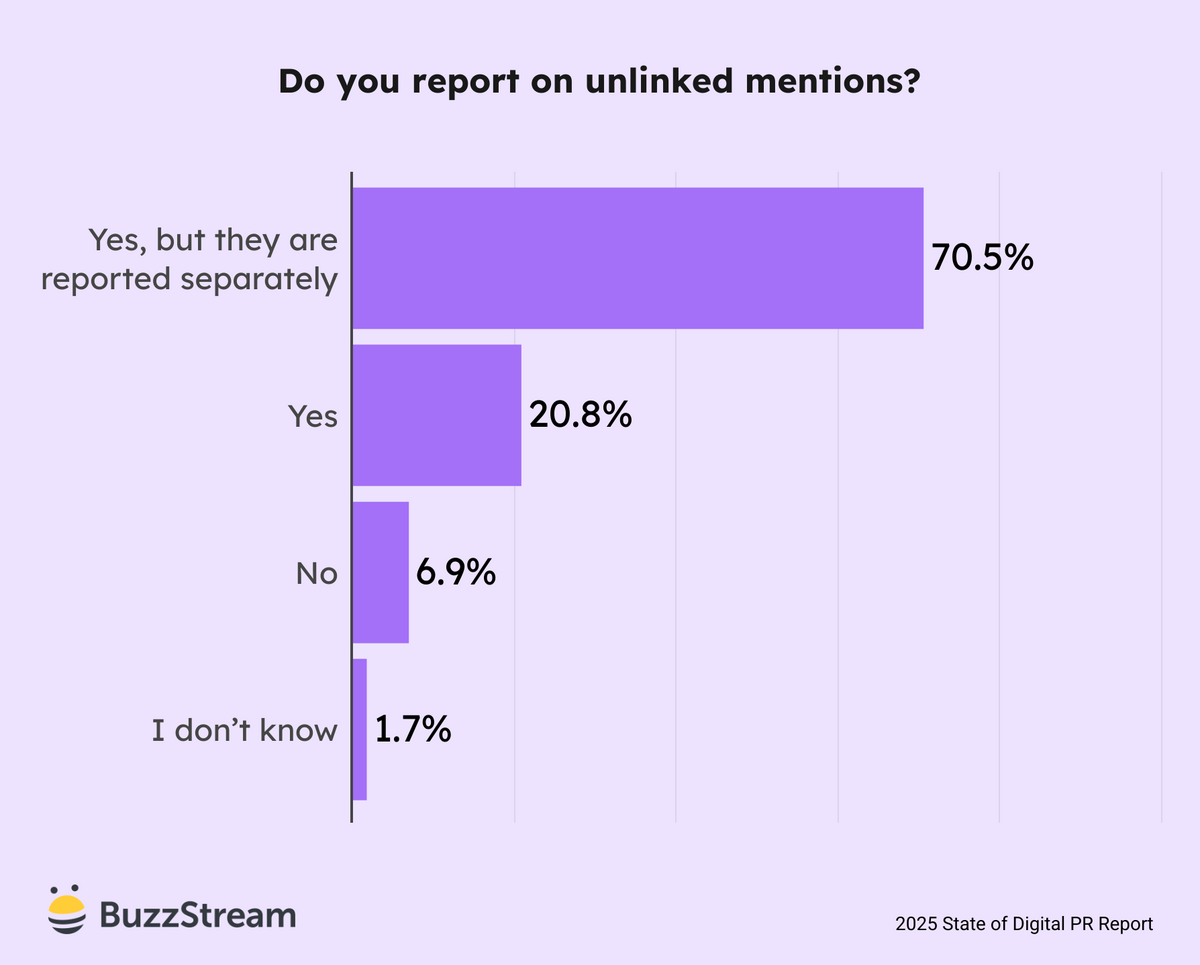
At a conference, Google’s own John Mueller told me that Google doesn’t view unlinked mentions at all.
However, this goes against studies that have shown otherwise, such as this one by Chris Panteli and Kyle Roof for Linkifi.
I think Hannah Smith of Worderist put it best:
“I think it depends on both the context of the unlinked mention, and the site which the unlinked mention appears on.
There are a range of high authority sites out there which either don’t include external links in their articles, and/or only rarely include them.
This presents something of a problem for Google, as in the past, they have relied on the linking behaviour of sites like these for authority and trust signals.
As such, I think it’s likely that Google treats some unlinked mentions (particularly those on high authority news sites, for example) as a signal of authority and relevance, and, therefore they may have an impact on search rankings.”
SEO-aside, from a pure brand awareness perspective, unlinked brand mentions, especially from highly-relevant sites, are gold.
As you’ll see in the following two sections, these can play a significant role in branded and direct traffic.
How to Track Impact?
I covered measuring most of this in a post on finding media mentions, including unlinked brand mentions.
To find unlinked brand mentions, I use Talkwalker Alerts to track mentions of BuzzStream.
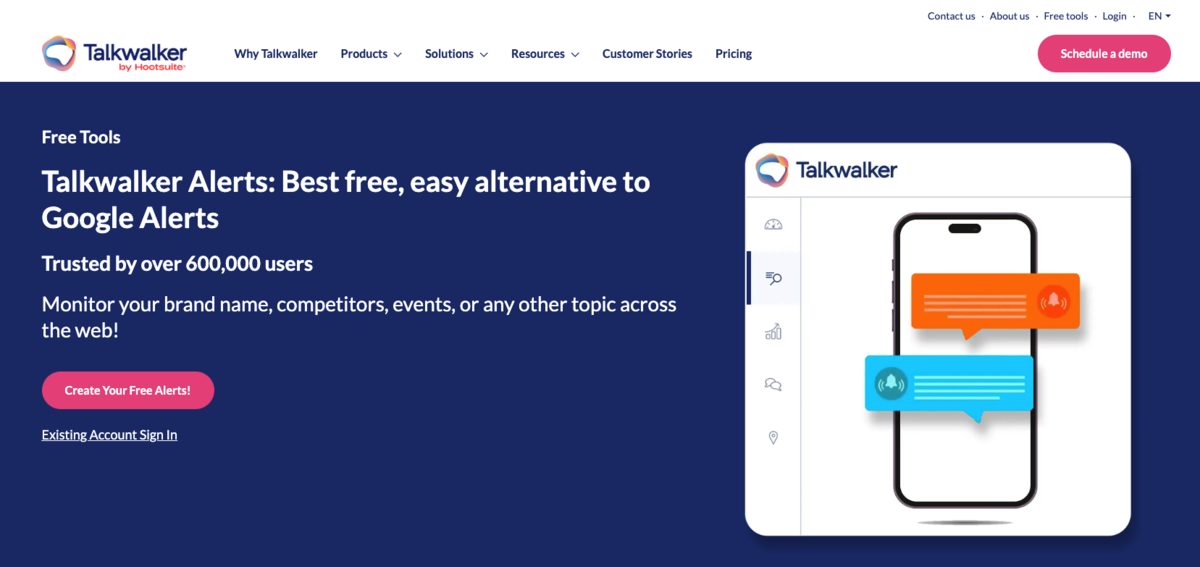
I’ve got one set up for BuzzStream and my name.
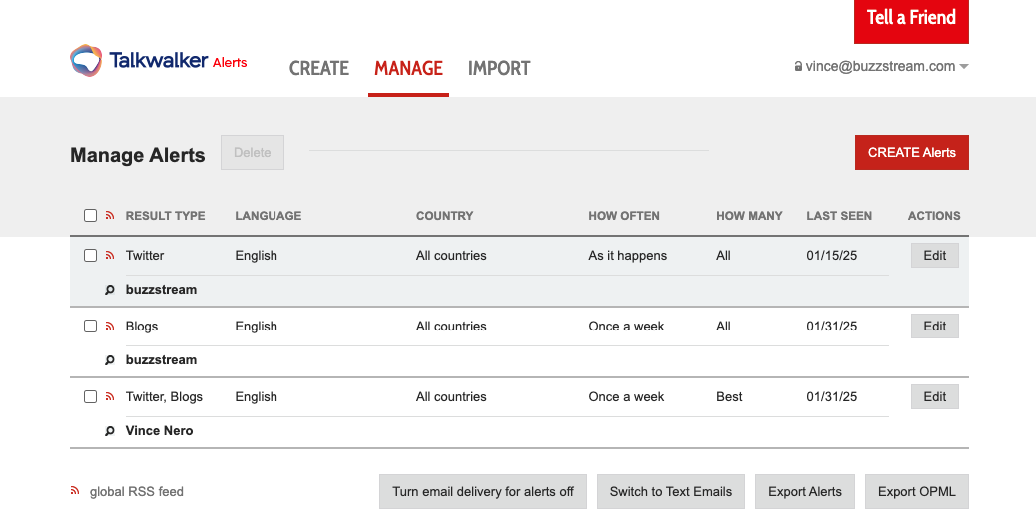
Then, they come in via email:
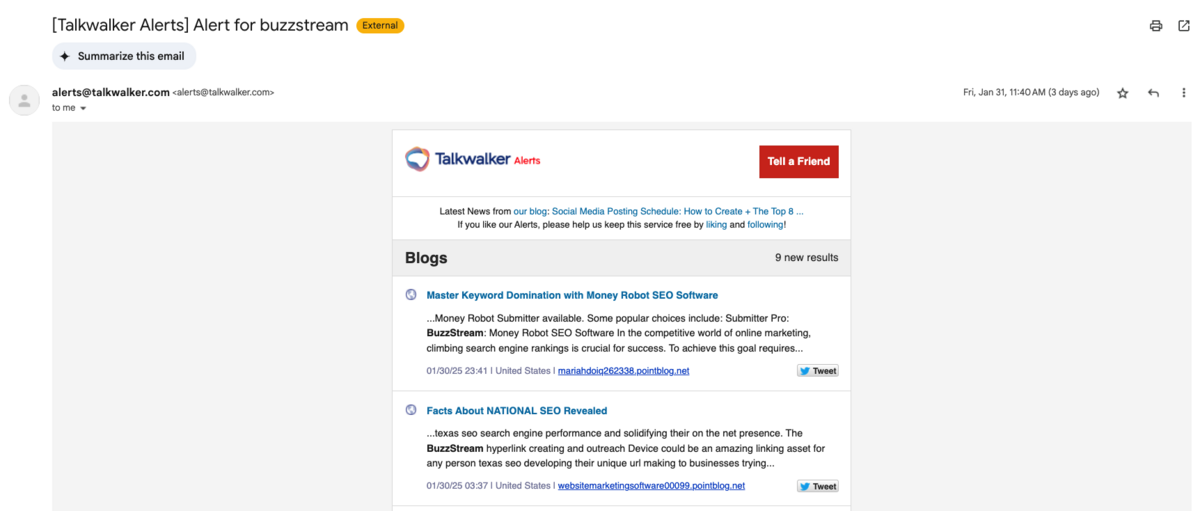
If it is unlinked, I’ll look for direct traffic spikes when publishing.
For instance, our State of Digital PR post went live on Jan. 28 and we started getting some coverage.
You can see a boost in direct traffic that next day:
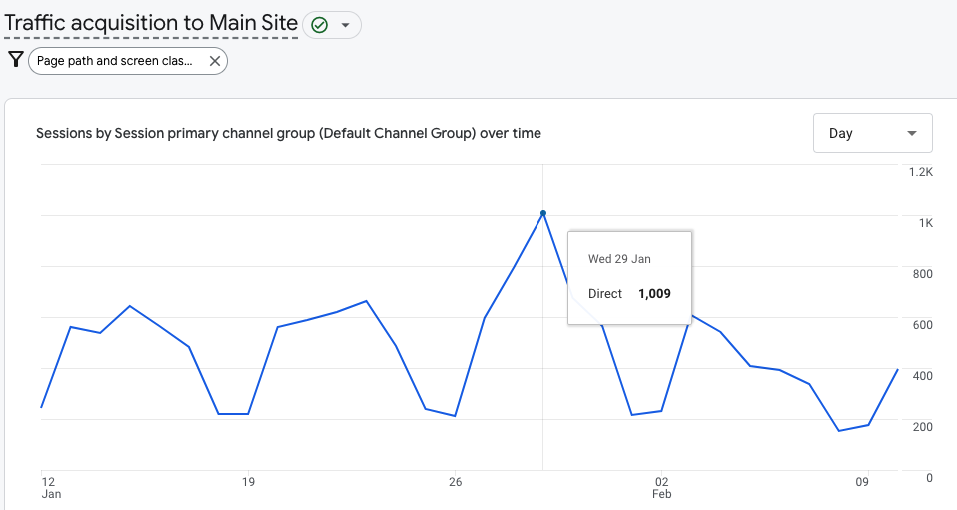
(I’ll also ask if they’d consider including a link.)
Talkwalker should also include mentions of newsletters and occasionally podcasts. However, I’d recommend the following tool for podcasts specifically.
To track podcast mentions, I use Podchaser.
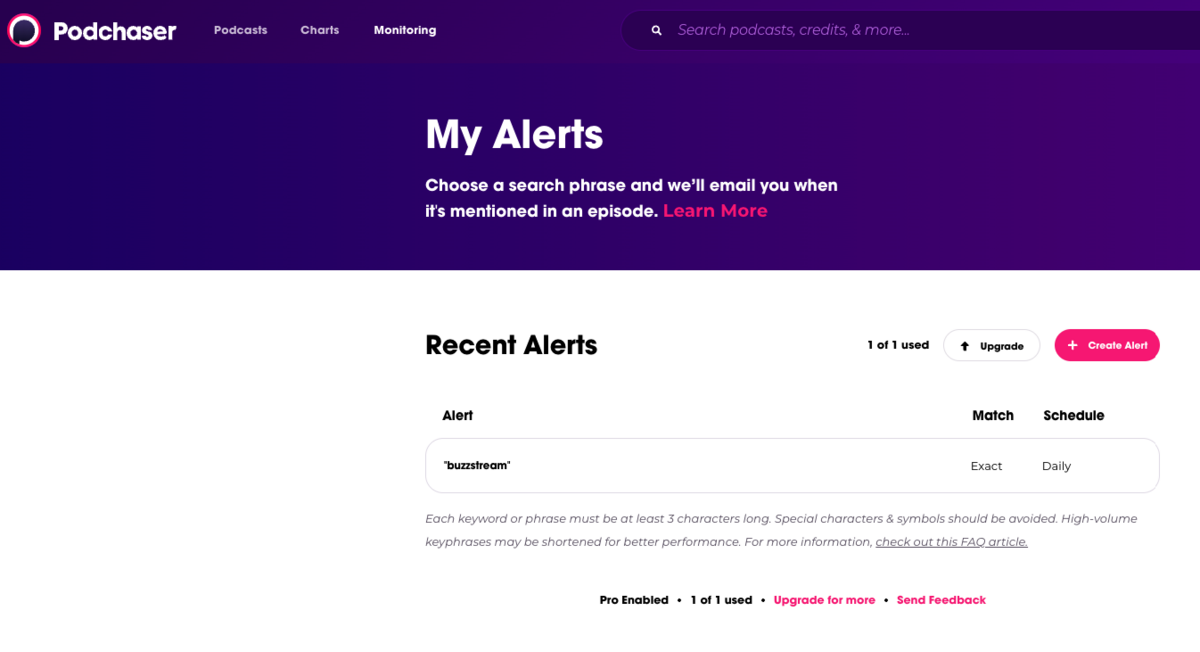
Again, when I’m mentioned on a podcast, I’ll look to referral traffic or direct traffic and see if there are any spikes there.
Free tools are limited. More comprehensive solutions exist. If you are getting paid to deliver, investing in a tool that tracks everything in one place makes sense.
How Long Until You See Impact?
Brand mentions come in immediately, but their impact on other metrics, like ranking, takes longer.
Verdict: Unlinked brand mentions still provide considerable value outside of just SEO.
4. Site Authority (DA/DR)
Sites with more links have been shown to have higher DR and rank better, driving more organic traffic.
In my experience, raising site authority is the primary reason sites want to build links.
According to our study, DR or Domain Rating is the most popular metric site authority digital PRs use, so we’ll focus on that.
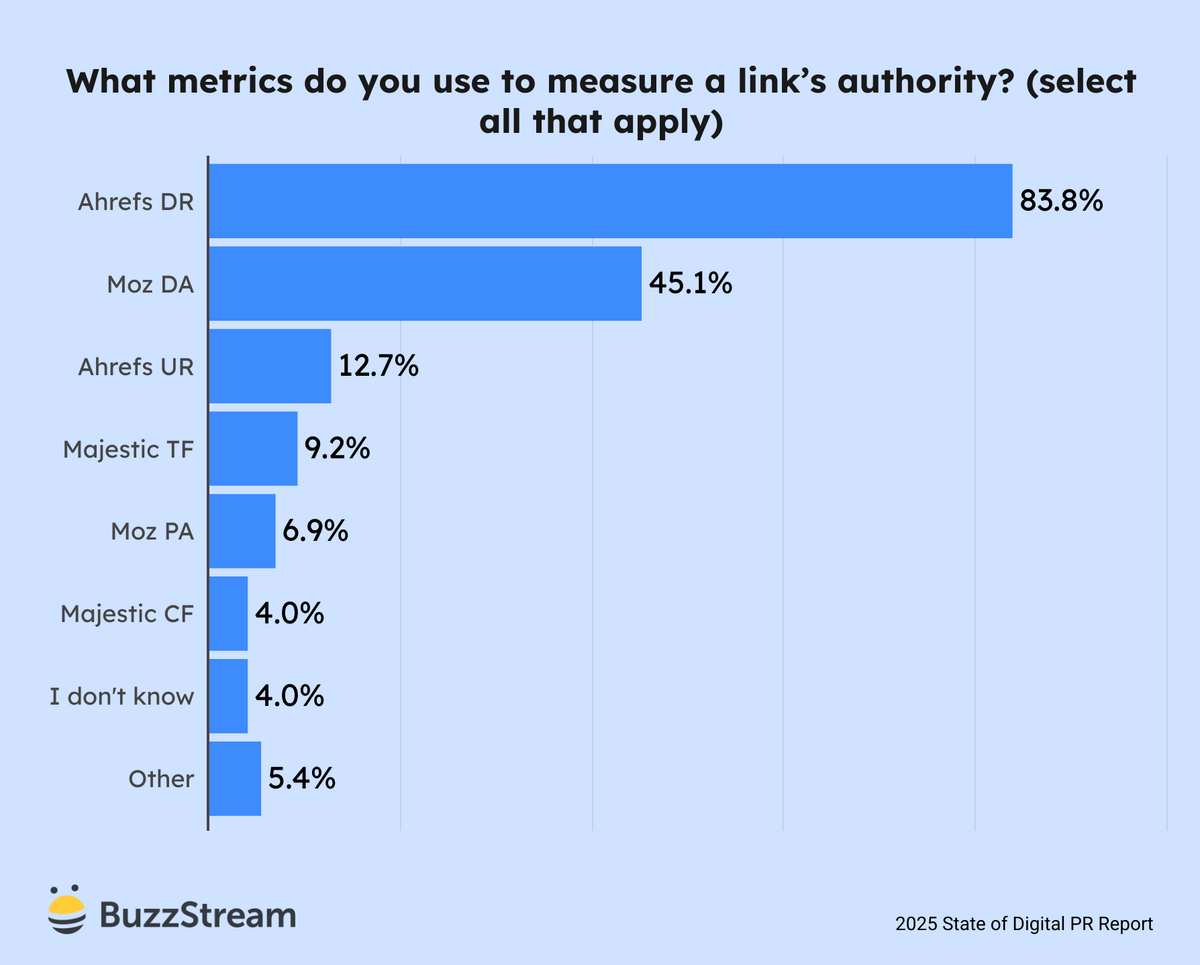
Ahrefs measures a site’s DR by “the strength of a website’s backlink profile compared to the others in our database on a 100-point scale. It’s essentially a less granular version of Ahrefs Rank (AR).”
What Does it Impact?
Overall site authority increases should directionally impact rankings and organic traffic.
The big caveat is that SEO best practices need to be in place.
If a site doesn’t have a great site structure, duplicate content, and slow page speeds, a lot of the link building work won’t be as effective.
How to Track Impact?
You can track your DR progress on Ahrefs. For instance, here is Lawn Love’s DR growth over time:
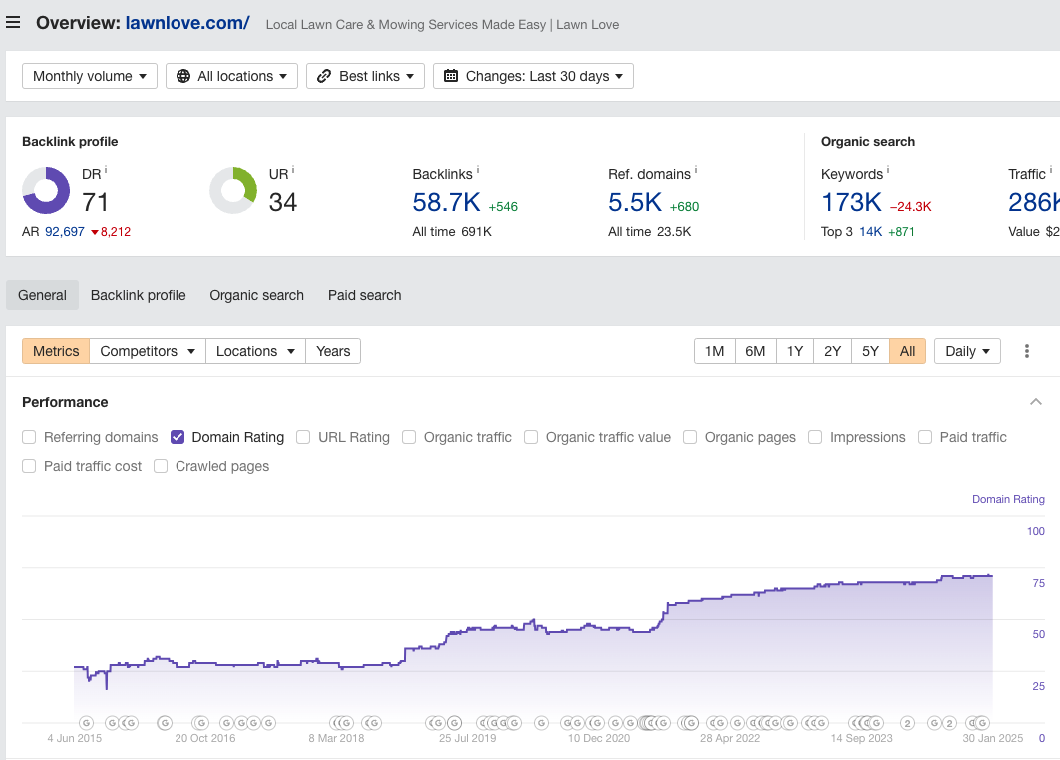
One big problem with these site authority metrics is that they can be manipulated.
In our podcast with Jasper Morris, he told us:
“If the referring domains of the site are a lot of jumbled up text with a DR but zero traffic, then what they’re doing is they’re using that to manipulate the DR of the site.
…They just manipulated it to seem like it’s ranking for more keywords than it is.”
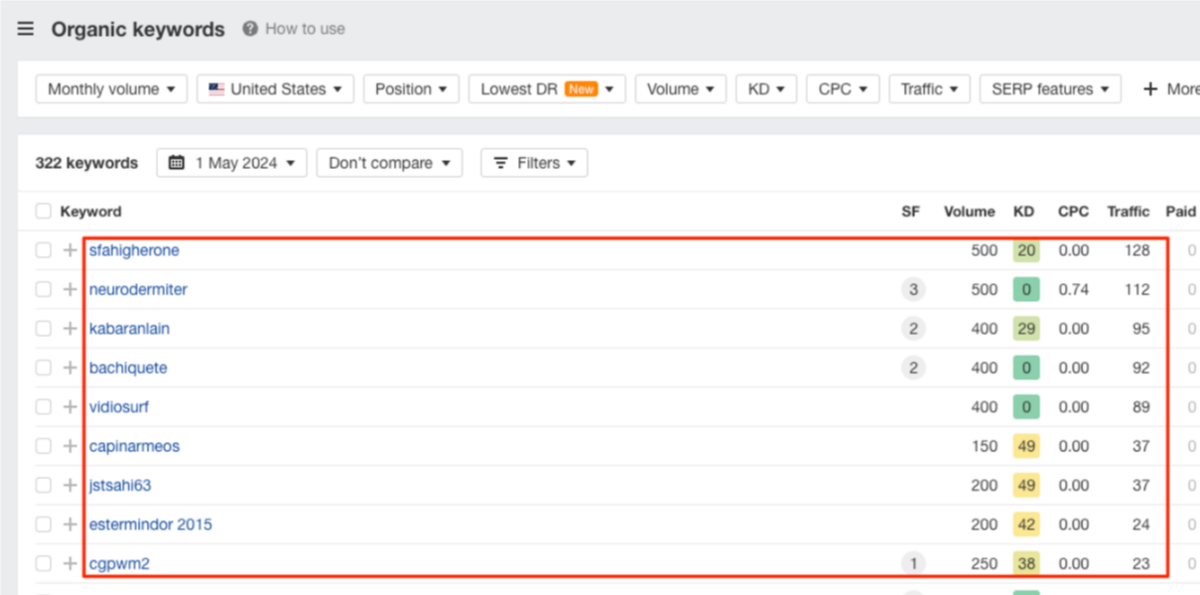
Another recommendation I have from my time working at an agency is that sometimes site authority shifts due to changes from the monitoring tool itself.
For instance, if Moz or Ahrefs expand their database of crawled sites, it may impact how they rate sites.
So, always compare your shifts to competitors. If you suddenly bump up a few points, but so do your competitors, take it with a grain of salt.
How Long Until You See Impact?
Authority metrics can take a long time to build up. And it depends on the amount of link building you are doing.
Here is a vacation rental company that went from 0-40 DR in about one year.
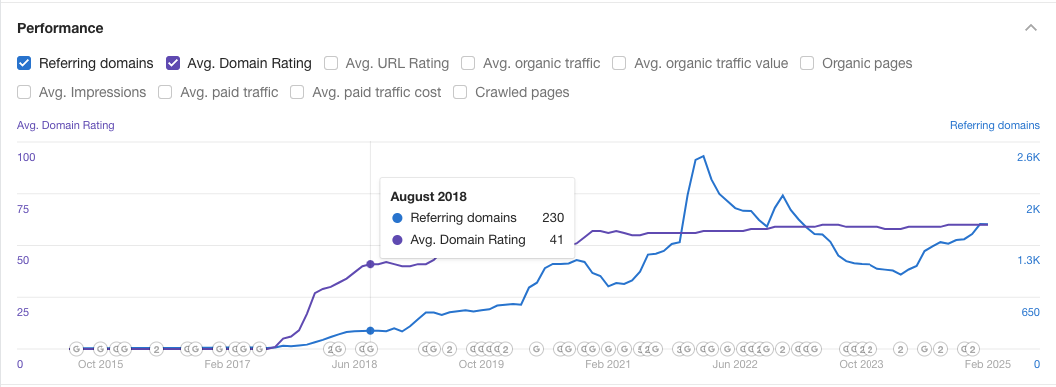
In my experience, it gets progressively more challenging to build the higher you get.
It’s much easier and quicker to go from 0-50 than from 50-75.
Here’s a snapshot of Monday.com since 2020. Despite healthy link growth, it took them about 5 years to go from DR 80-90.
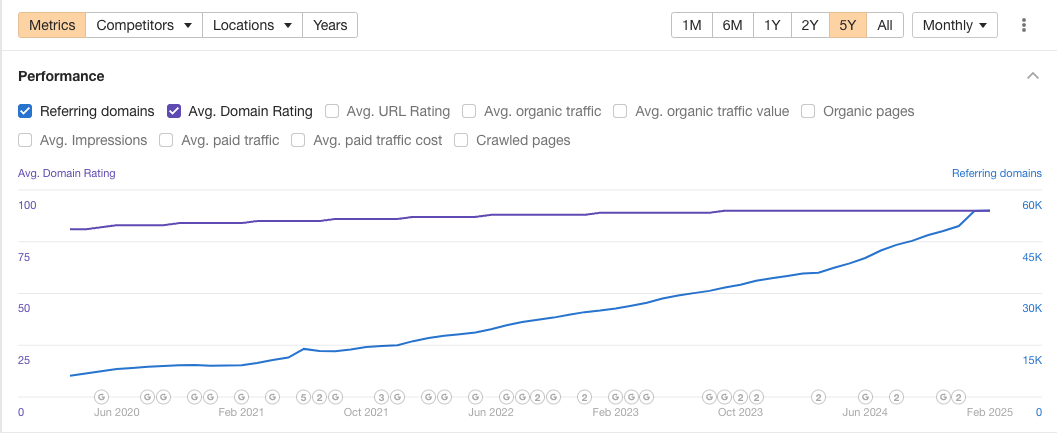
So, when I evaluate or report on DR, I always look at quarterly or even yearly growth over monthly.
Verdict
Think of site authority as a long-term growth metric. It won’t happen overnight.
5. Page-Level Organic Traffic and Rankings
Why? More links can also build page-level traffic and boost rankings.
(If you aren’t looking to track metrics for a specific page, you can skip this section.)
If I’m working on an asset-driven digital PR campaign trying to rank for a keyword, I look at organic traffic and rankings for that particular page.
I also want to specify here that I’m talking about non-branded keyword terms. I’ll get into branded at #7 on this list.
For instance, I published a link building statistics post, so I like to track its impact and progress every week:
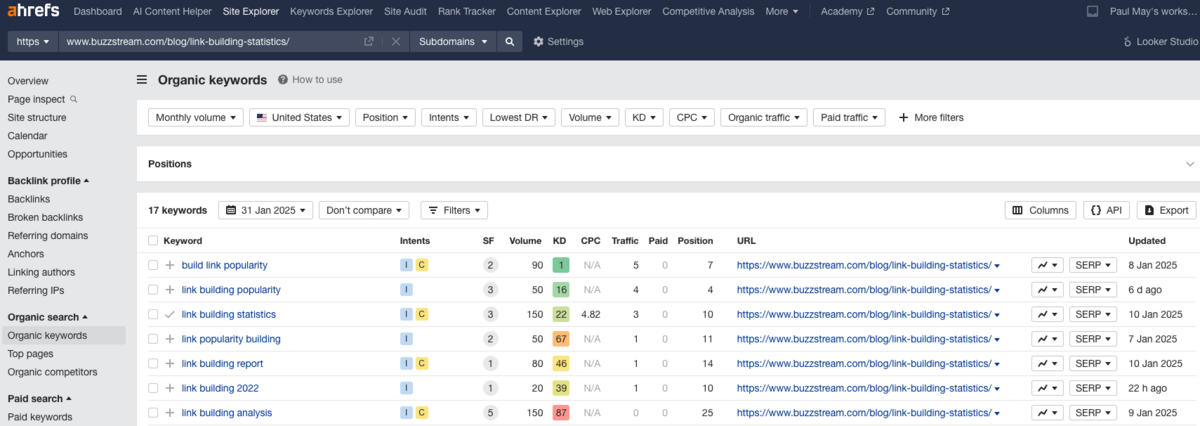
The rankings should lead to organic traffic increases.
So, I can also look into the organic traffic it brings with Google Analytics or Google Search Console:
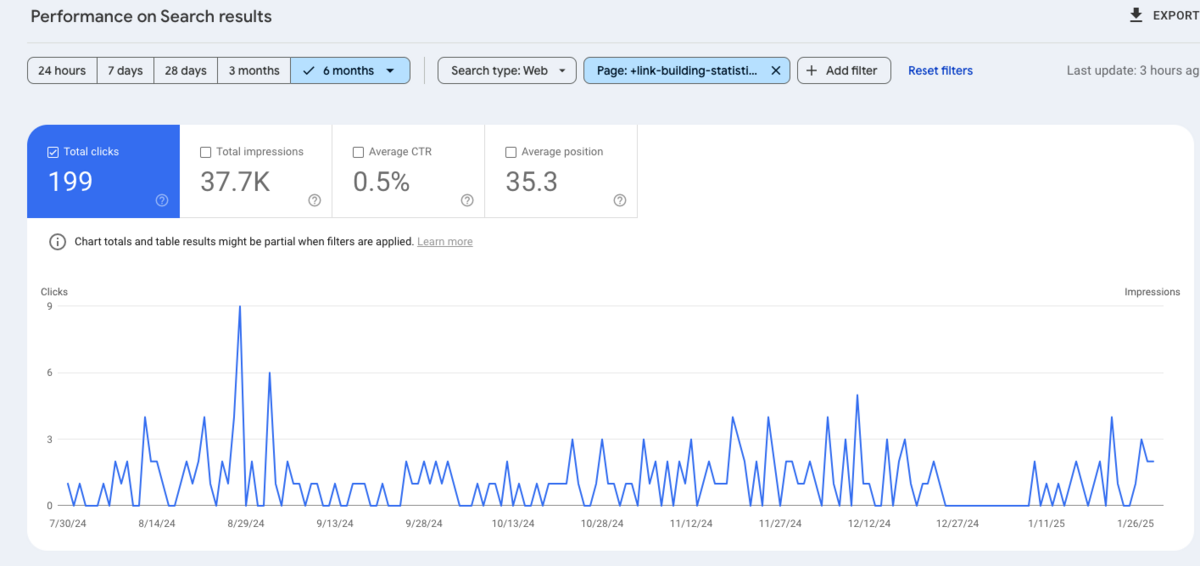
As you can see, it’s not doing much for me…yet.
What Does it Impact?
Organic traffic to a page brings site visits, which can lead to conversions.
The quality of that traffic is directly related to how relevant the content is to your brand.
If you’re building links to content that is far from your core audience, I wouldn’t expect it to convert.
That’s not to say those links are valuable. As we saw in the previous sections, links from digital PR have softer goals, like supporting overall site authority and rankings.
Some make the case that getting links from sites outside of relevant areas is OK because it builds a diverse backlink profile. I think there’s some truth to that but only to a point.
I won’t go out and build links to BuzzStream from ESPN and expect it to be relevant in Google’s eyes.
I would stick to quality, relevant links.
How to Track Page-Level Organic Traffic?
There are a few ways to measure organic traffic. In order of reliability, I start with Google Search Console, Google Analytics, and then Ahref’s Site Explorer. (I’ll explain why in a bit.)
To measure organic traffic using Google Search Console, you can see the organic traffic by finding your URL under the Pages tab and looking at Total Clicks.
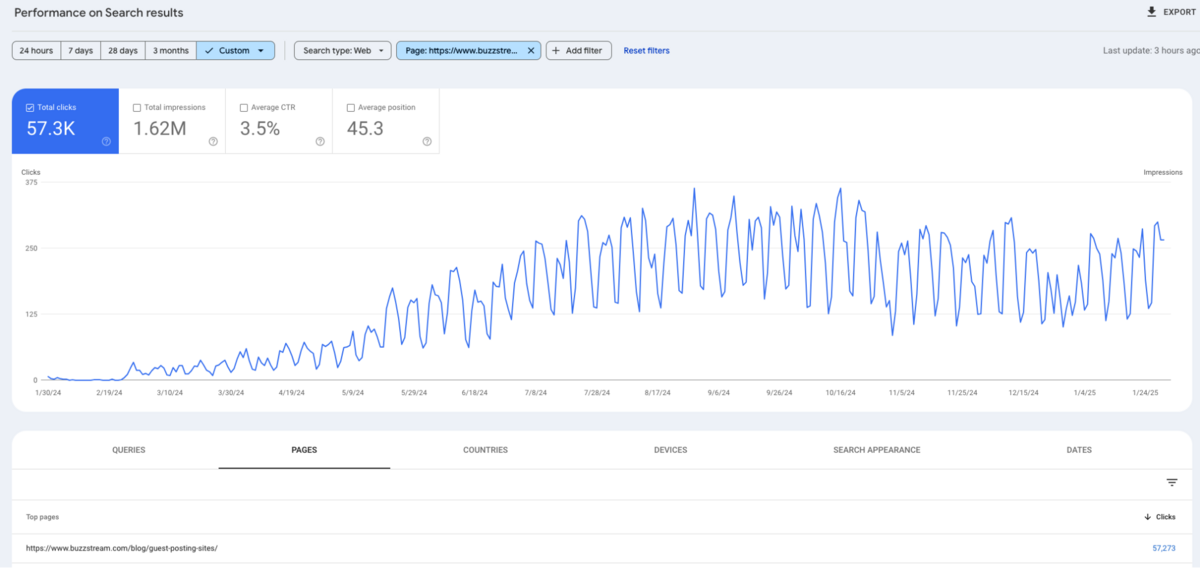
This will show you the number of clicks going to that particular page. (You can also toggle on metrics like Average CTR or position.)
To measure organic traffic using Google Analytics, go to Engagement>Landing Page.
Then, add the Organic Traffic segment at the top left by clicking “Add comparison.”
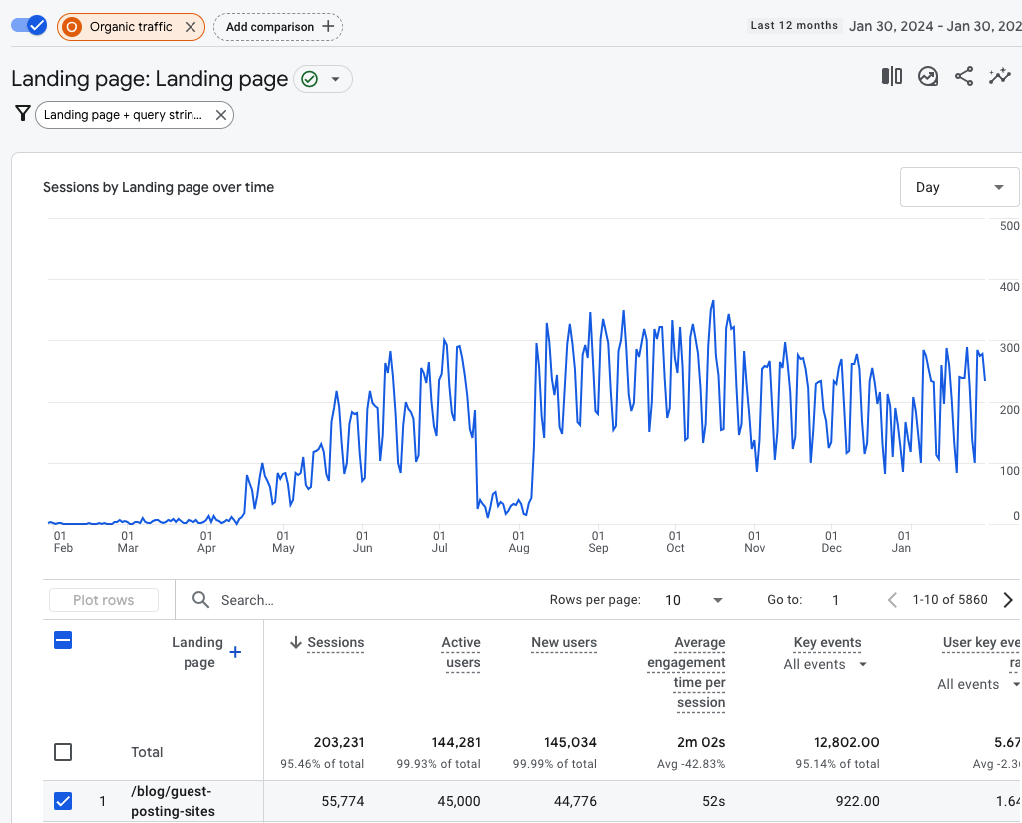
As you can see, my guest posting site slowly started to gain traffic in mid-April 2024.
You’ll also notice find that Google Analytics and Search Console don’t match exactly.
There are a few reasons here.
I’m looking at Sessions in the above screenshot, which will be slightly lower than clicks because the same user can have multiple sessions.
Google also ignores some data for privacy purposes.
Just keep in mind that Google Analytics and Google Search Console are not as friendly with one another. (Something that Google addressed in a helpful video recently.)
To measure organic traffic without analytics access, use Ahrefs’ Site Explorer.
Type in the URL and see the Organic Traffic under the Performance section.
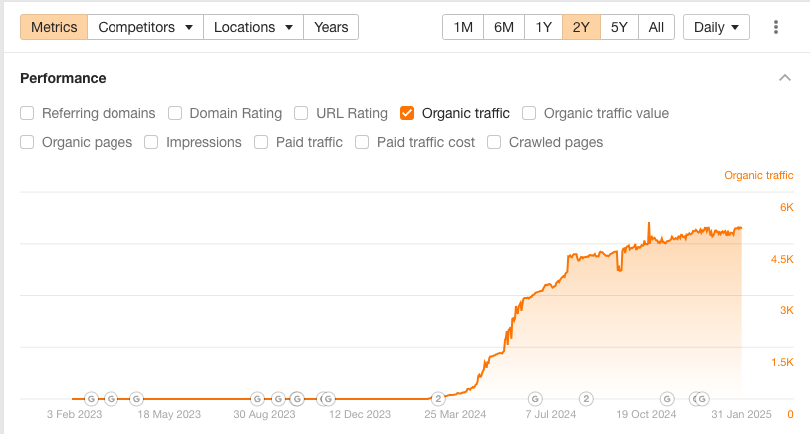
You can also look at their estimate here:

Ahrefs provides an estimate based on the search volume for the keywords the page ranks for. Compared to GSC, which has an average of 4,385 clicks, Ahrefs’ estimated monthly visits of 4.9k is pretty close.
How to Track Page-Level Rankings?
As I mentioned, rankings and organic traffic typically go hand in hand. I like to consider organic traffic the leading metric because that’s the ultimate benefit of a rankings boost.
But rankings are core to the SEO world, so let’s look at how to measure page-level rankings.
A keyword tracking tool like Ahrefs or SEMRush is the best way to measure rankings.
With Ahrefs’ Site Explorer, simply add the URL and go to Organic search>Organic keywords on the left sidebar.
For instance, here are the rankings for my guest posting sites post:
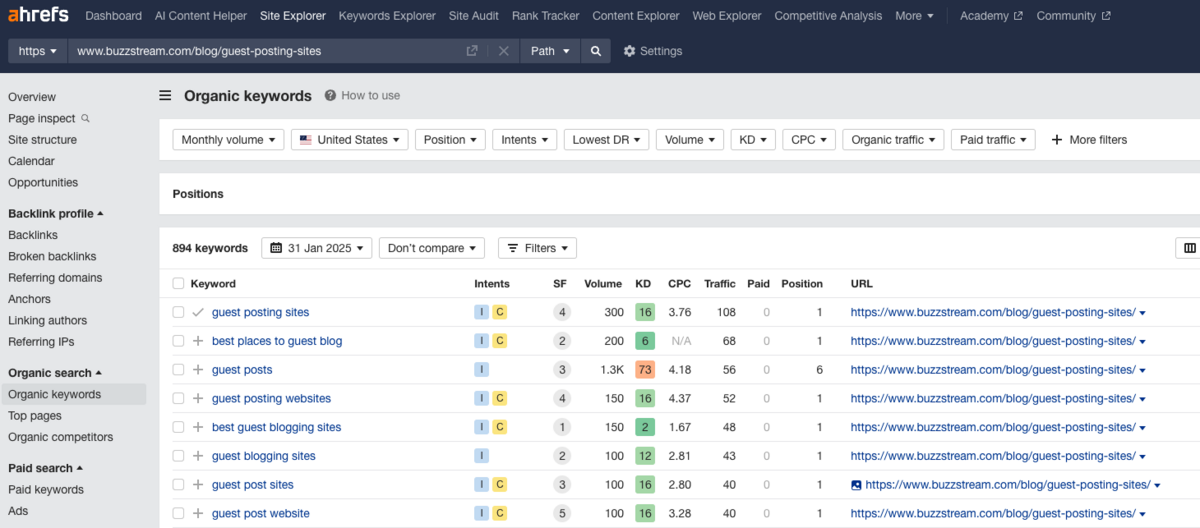
I can toggle the comparison feature to see how the positions have changed:
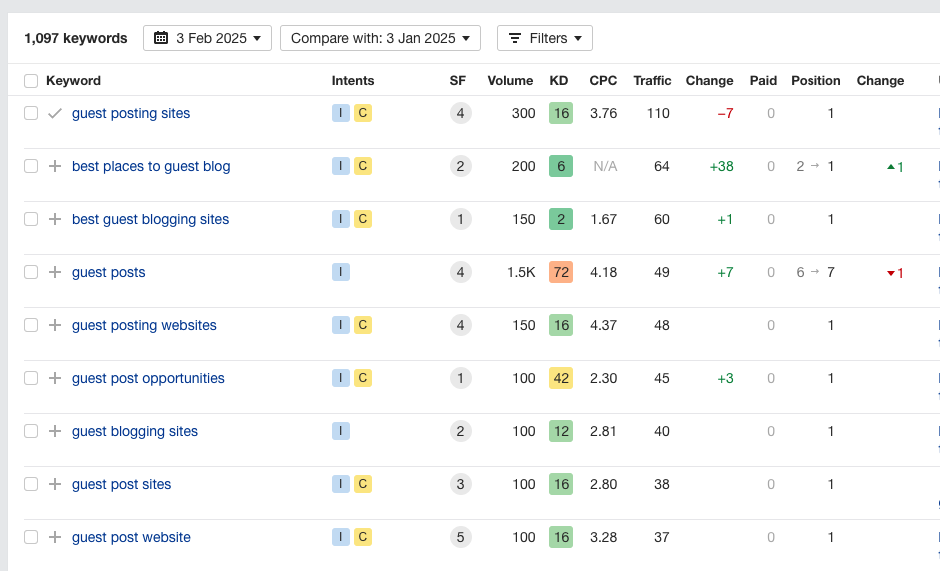
I can also use Google Search Console and look at the queries driving traffic to a specific page, but it’s a cumbersome process.
In GSC, I click on the specific page you want to look at:
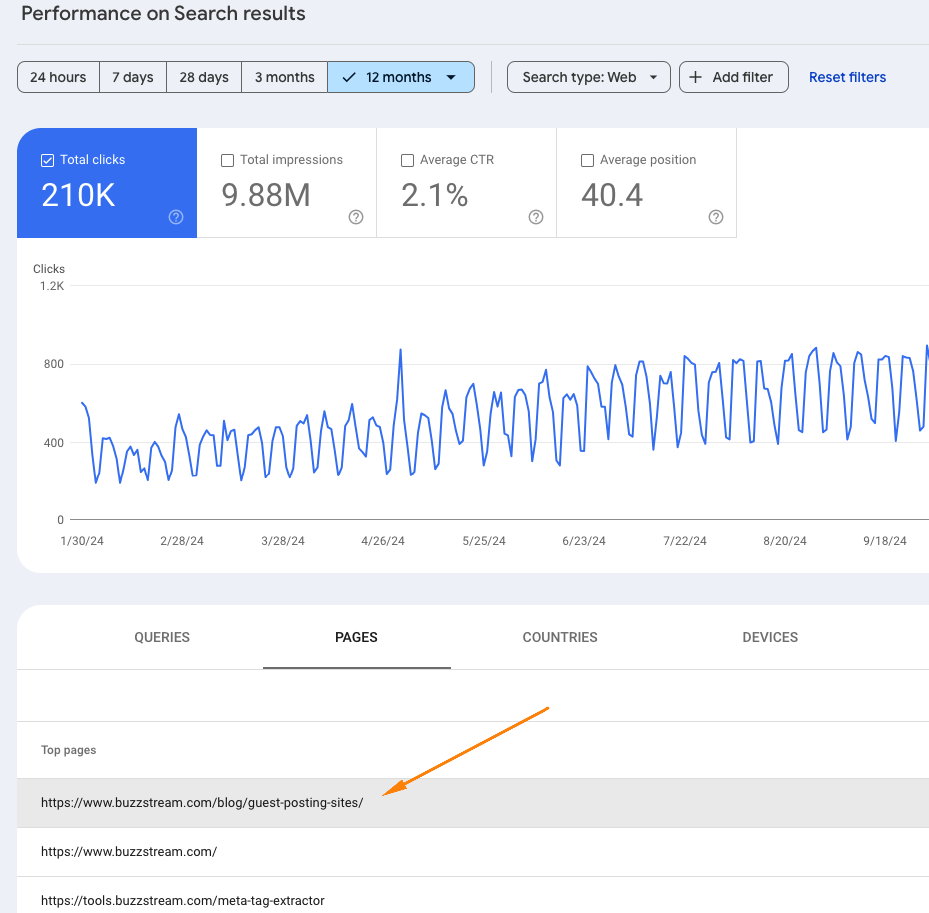
Then I see the queries driving clicks to that page:
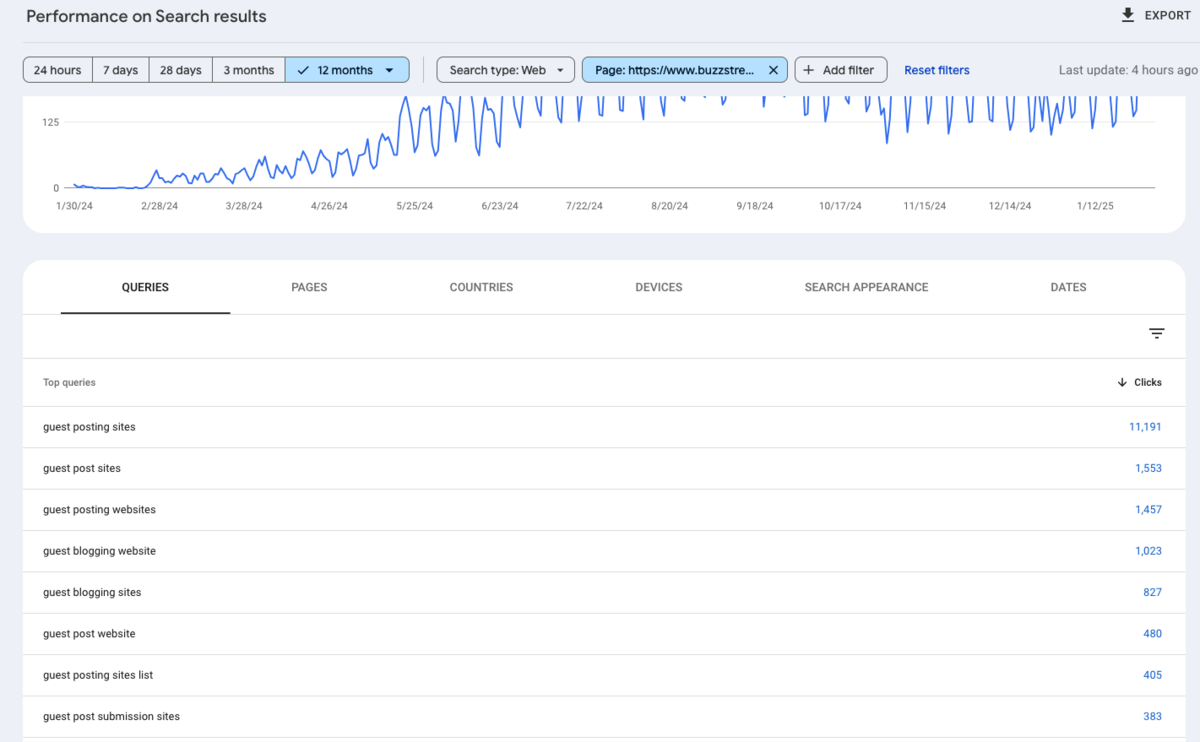
Then, to track the change, I can use the comparison feature:
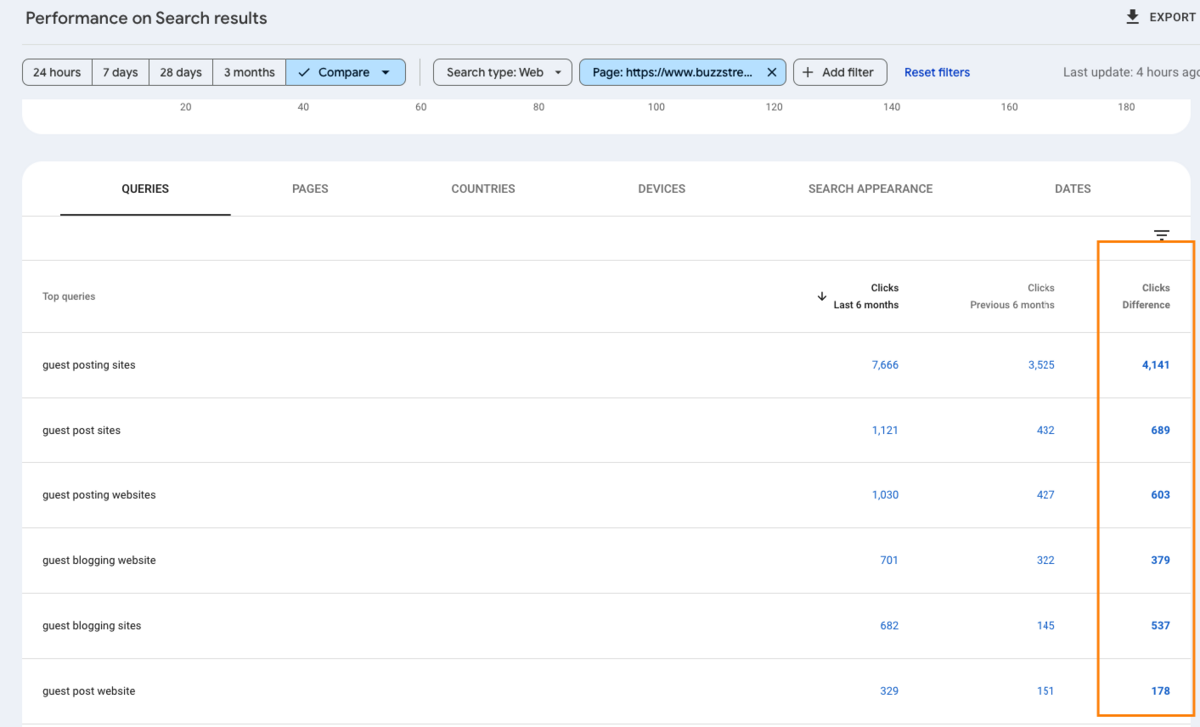
How Long Until You See Impact?
In my experience, it takes, on average, about 1-3 months to climb the rankings and eventually settle where it will rank.
However, in some cases, like for me at BuzzStream, some keywords rank more quickly than others.
In the case of a link building statistics post, like mine above, it usually takes 8-12 months to see the true impact because they build links passively.
You can hear more about this strategy from Darren Kingman on our podcast.
Verdict: Measuring organic traffic is one of the best ways to align digital PR with the SEO team’s goals.
6. Sitewide Organic Traffic and Rankings
Why? Sitewide organic and rankings give a sense of the trending impact of digital PR.
Sitewide traffic and ranking gains offer a macro look at how digital PR investments pay off in the long run.
Remember, if we gain links, our authority should rise, making ranking easier.
Therefore, when looking at a site’s organic traffic and links, we should expect them to rise together.
When I was with Siege Media, our rallying call on monthly reports was always, “Up and to the right!”
For instance, here’s a graph from Preply, who has invested heavily in digital PR in the past few years:
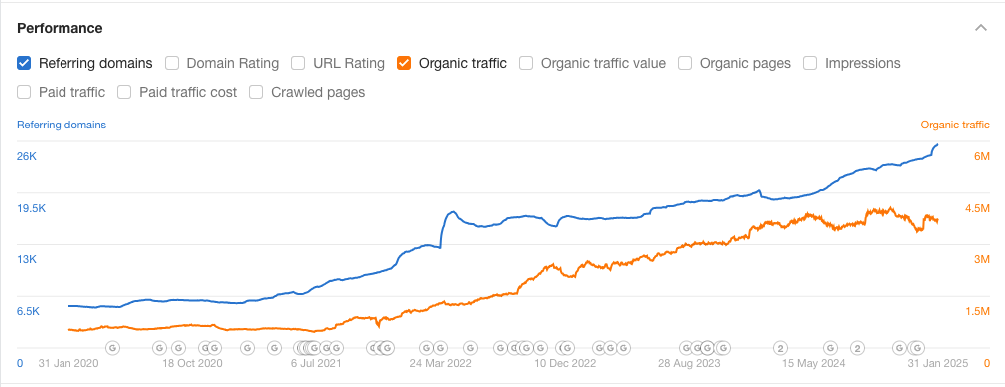
Both organic traffic and links move up and to the right at the same rate.
However, this metric gets a little less reliable if there are a lot of other content marketing and SEO initiatives going on at once.
This works best when an agency or consultant owns all SEO and content marketing aspects, including digital PR.
What Does it Impact?
Improving organic traffic sitewide brings in more visitors, which can lead to conversions.
Again, if you expect traffic to eventually convert or spread your brand, it should come from relevant sources.
How to Track Impact?
You can measure using the same workflow as the previous one, only looking at sitewide instead of an individual URL.
Then, look for bumps in traffic around the same time a campaign went live.
For example, when I looked at a coronavirus.com signage asset from Signs.com, published during the Pandemic in 2020.
It proceeded to get 200+ backlinks in the next few months.
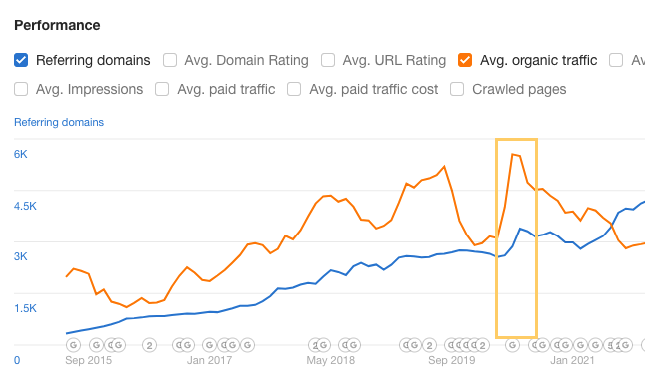
You can see the organic traffic move with the links.
Keep in mind this isn’t an exact science. Other things may be happening at the site or external factors like Google algorithm changes.
But, think of it like directional credibility or legitimacy to your campaigns.
How Long Until You See Impact?
In my experience, it typically takes six to eight months to see the sitewide impact of digital PR campaigns.
Verdict
Sitewide traffic is a tremendous directional signal for digital PR and provides a good amount of trust in the process. But it doesn’t happen overnight.
7. Branded Keywords and Branded Traffic
Why? Many thought leadership and creative digital PR efforts are specifically created to boost branded search and keyword ranking.
Branded keywords help drive traffic for a lot of sites. Even if you aren’t building links directly to the homepage, PR efforts should help branded keywords rank as long as key pages are internally linked.
The content we published on the State of Digital PR had that goal.
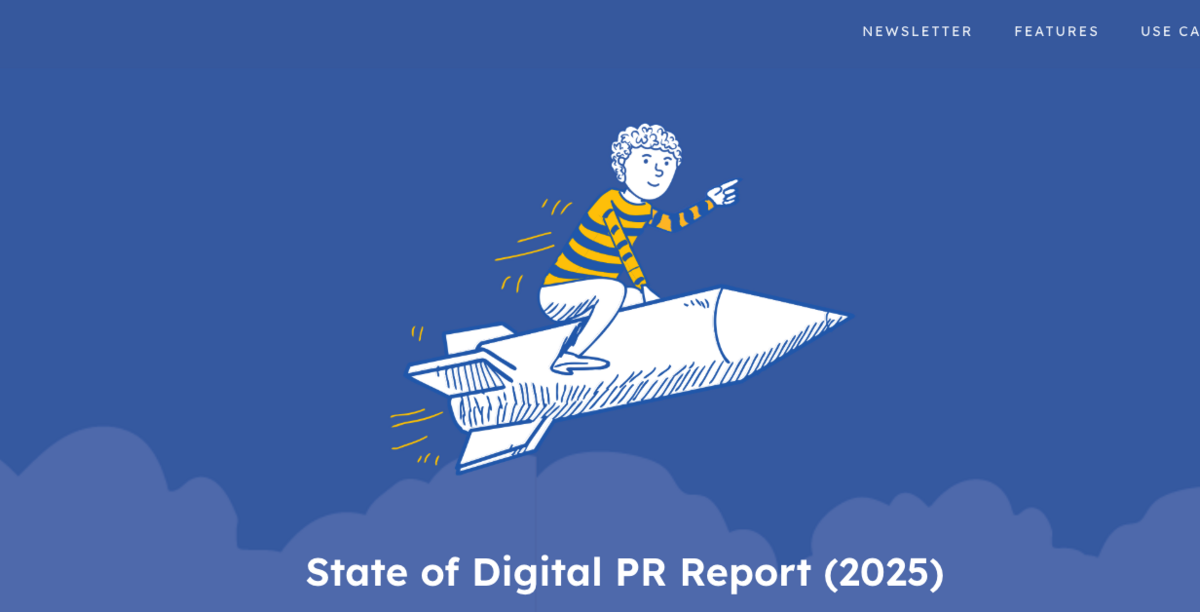
As I generate links to the report, link equity gets passed to other site areas, including my homepage, where most branded terms rank.
When looking at BuzzStream, over the past 5 years, I can see we are some all-time highs:
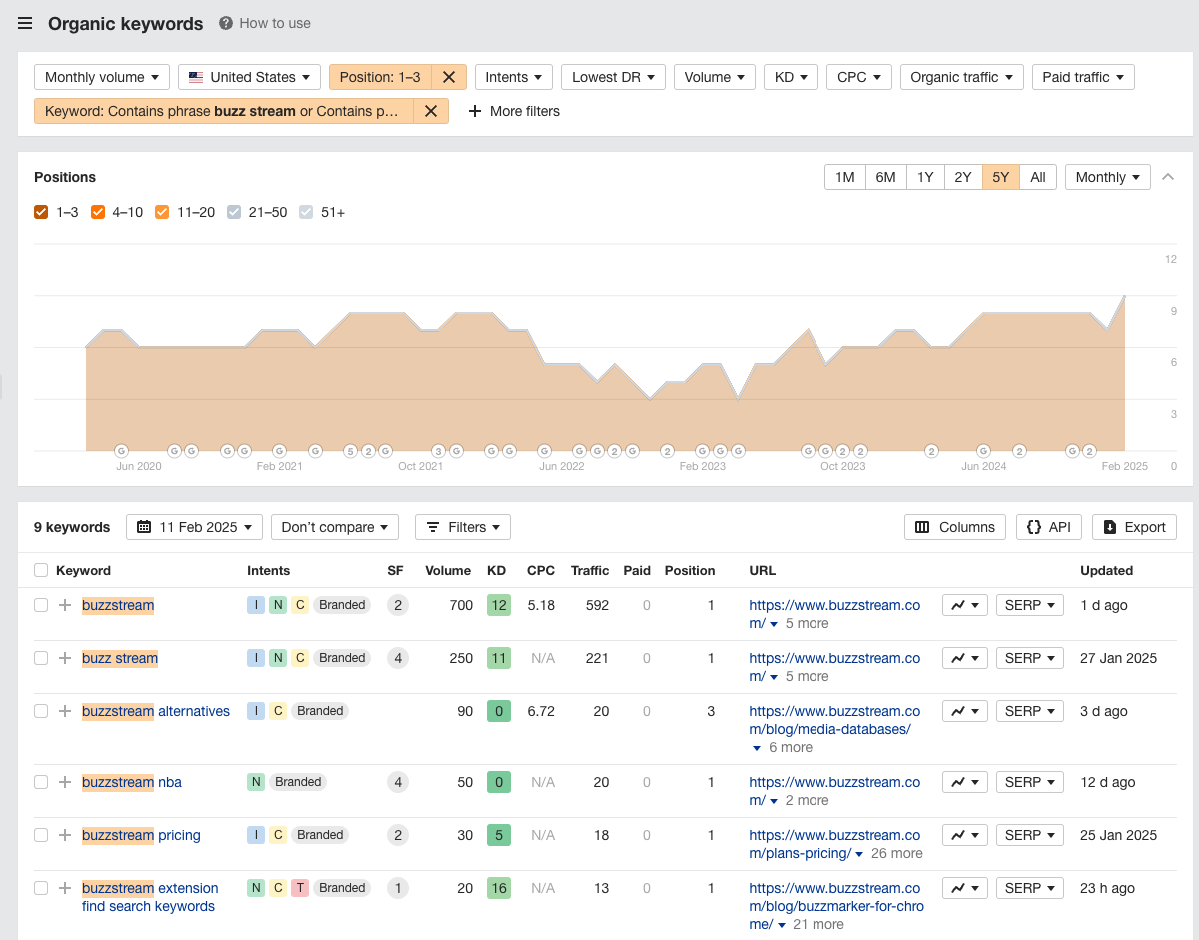
You can even see a boost at the end, right after our State of Digital PR posted.
What Does it Impact?
Branded keywords can have a significant impact on the bottom line.
I want to own the keywords that refer to BuzzStream to control the narrative.
I consider “buzzstream reviews” and “buzzstream alternatives” to be branded keywords.
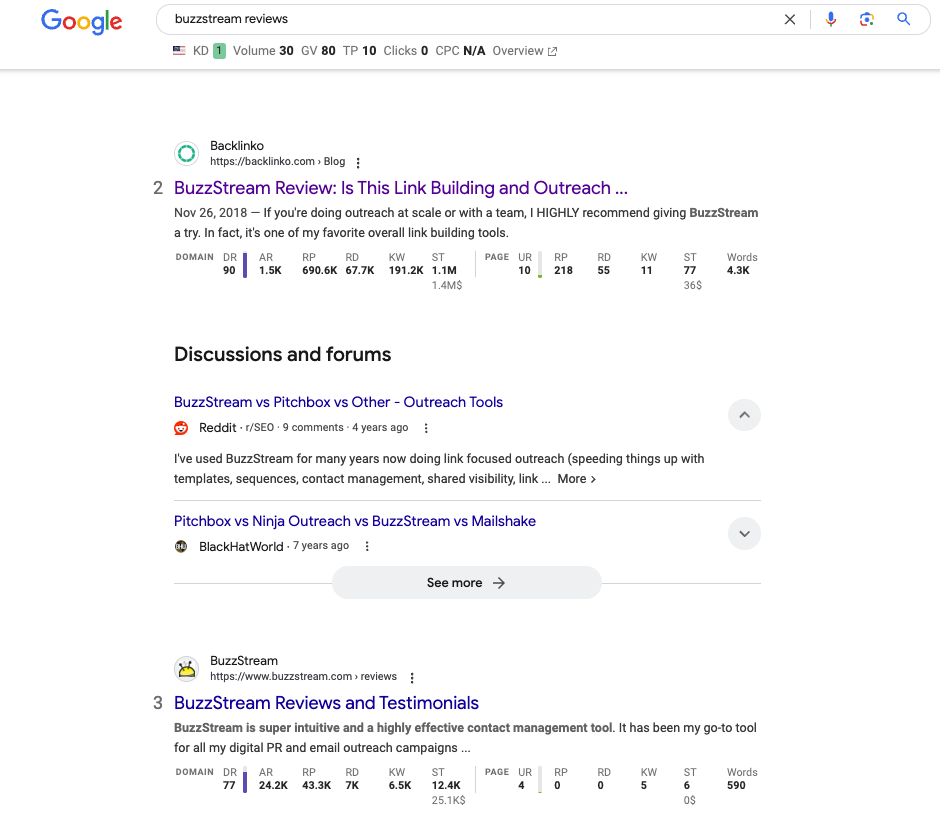
Many SaaS brands (ourselves included) strategically create content around those keywords because they are bottom of the funnel.
How to Track Impact?
Tracking branded keywords and traffic is the same process as measuring non-branded keywords.
If you have access to Google Search Console, the Queries tab should provide a snapshot of all of the queries coming into your site from Google:
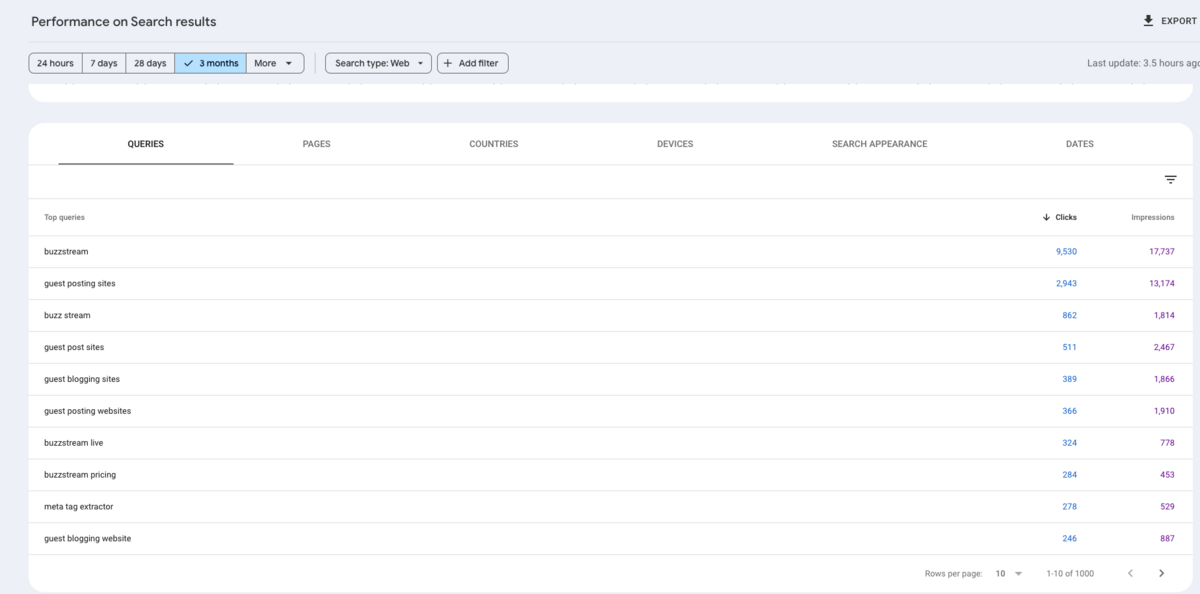
Use the filter option to enter the keywords. For instance, I’ll type in “buzzstream”:
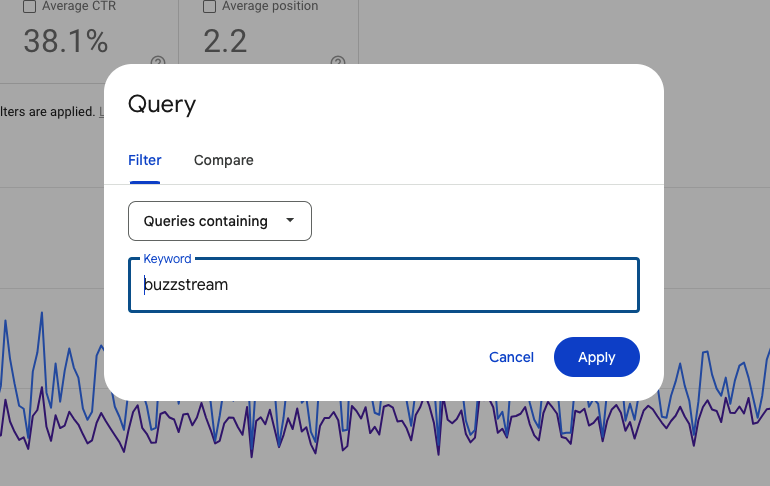
Then, I can track progress over the year.
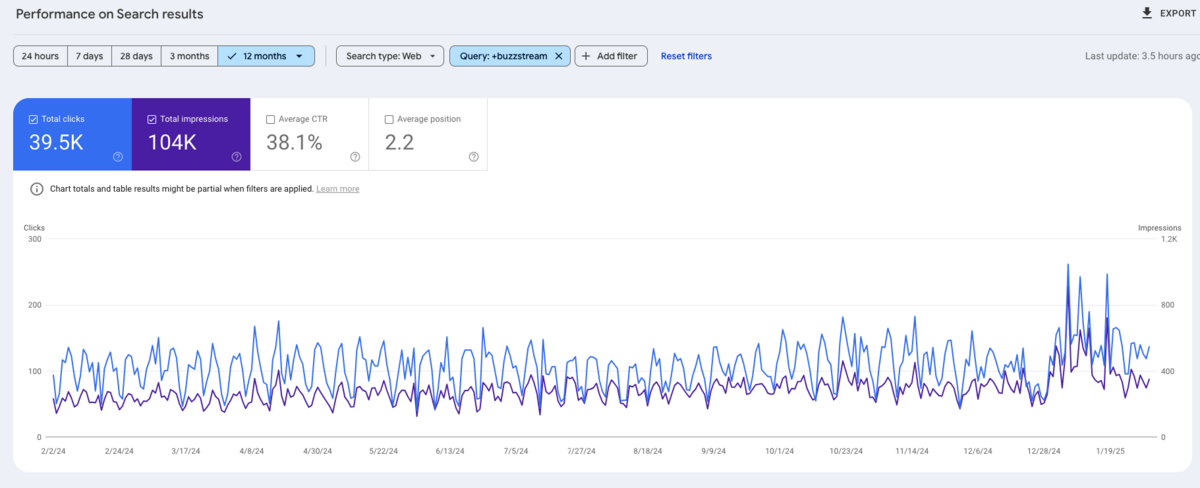
There will be some noise when branded keywords overlap with other terms.
For instance, we rank for many queries related to a streaming site called Buffstreams. (I haven’t searched for it, and I don’t recommend you do either…just in case.)
Also, for SaaS products like ours, branded traffic is often navigational. For instance, about half of our users search “buzzstream” on Google to log into their accounts.
That isn’t traffic I’d want to measure from digital PR efforts because these don’t represent customers.
If you don’t have access to Search Console, you can use Google Trends.
Simply type in your brand name as a search term.
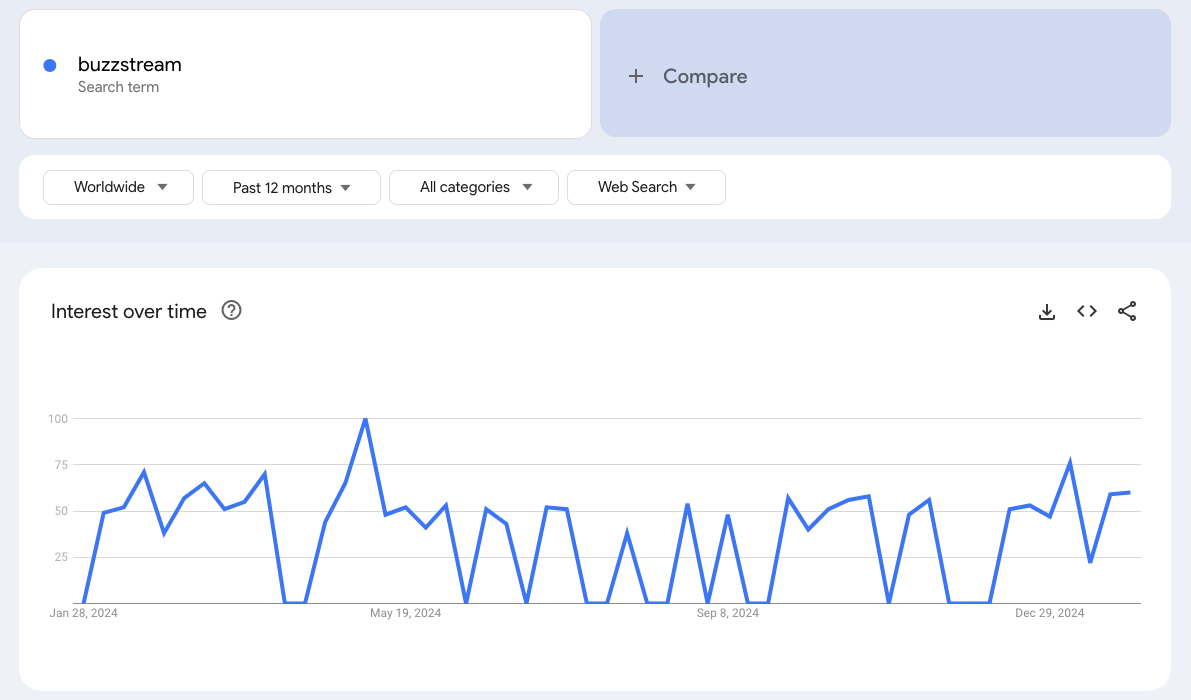
This gives a nice macro-level sense of how interest in your brand is trending. You can also compare it with competitors to see if interest in your site is waxing or waning.
How long until you see the impact?
I’ve seen branded keywords start ranking within a few weeks, with quality links and traffic coming to a site.
But, brands in more competitive industries can take much more time and links.
Verdict: Branded traffic is definitely a metric that stakeholders and clients should be interested in.
In the next section, we’ll talk about direct traffic, indicating brand awareness.
8. Direct Traffic
Why? Direct traffic can sometimes be used to measure brand awareness.
Direct traffic comes from users who type a site URL directly into their browser or from a bookmark.
As you can already tell, SaaS businesses may face the same problems where users only come to the site to log into their accounts.
But, with proper filtering, you can cut this down.
What Does it Impact?
Direct traffic brings high-intent users to your site.
They already know you and they know they need your site specifically to answer a question or do whatever task they have set out to do.
How to Track Impact?
To measure Direct traffic, you need to use a tool like Google Analytics.
You can find it under the Acquisition under the Reports Tab on the left sidebar.
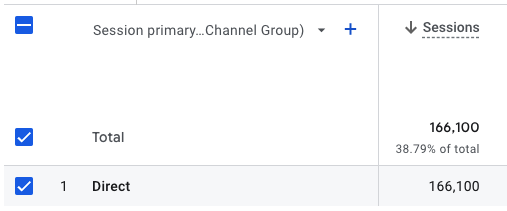
Keep in mind that direct traffic can be very misleading for any site that requires users to login. For instance, many BuzzStream users bookmark our site in order to login, leading to direct traffic.
For SaaS businesses, you can set up filter views by clicking the pencil icon on the top right and filtering out any key pages users visit when logging in.
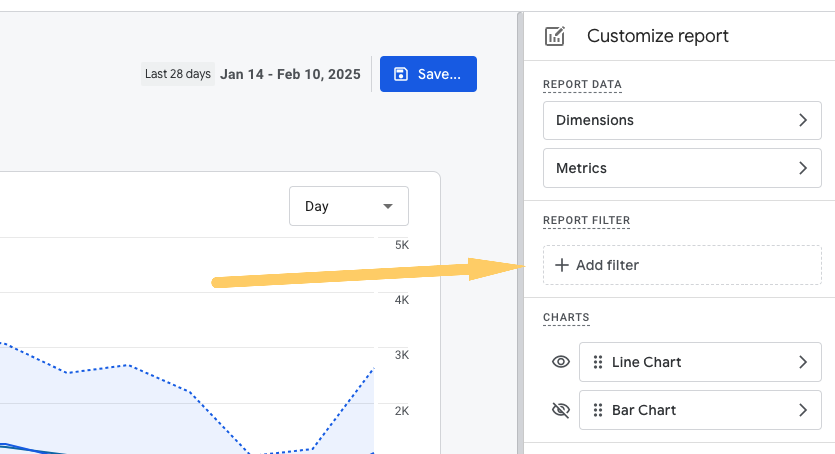
For BuzzStream, it was /login/.
How Long Until You See Impact?
Direct traffic is immediate. But to see the impact of direct traffic from digital PR efforts, you’ll need to track the publish dates and how your content is performing.
For instance, we saw a spike in direct traffic at the end of January. This coincided with our State of Digital PR post going live and getting picked up by various publications and newsletters.
(Note, the below is filtering out all of the users going to Buzzstream.com just to log into the app.)
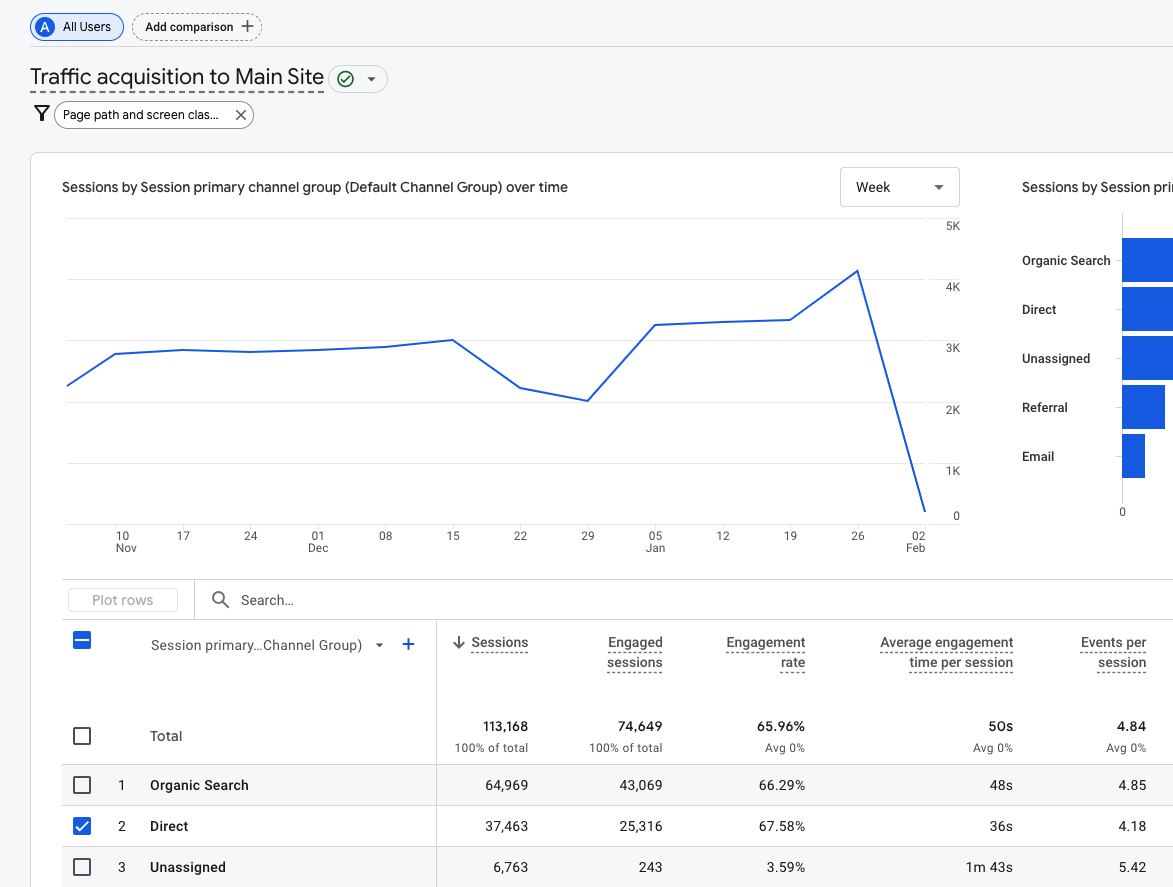
Sometimes, spikes occur weeks or months after your digital PR efforts because certain major publishers may write a story, exposing it to new audiences.
We discussed how Launch Potato’s fast food inflation post saw a second life after a few major news outlets picked it up.
Verdict: Direct traffic can be a noisy metric—especially for SaaS brands, but it can be a signal of overall brand awareness.
9. Social Media Mentions and Social Traffic
Why? Today, it is relatively standard practice for most digital PRs to use social media or coordinate with social teams to promote campaigns through social channels.
Depending on the demographic, social media may be one of the top platforms for your brand’s customers.
What Does It Impact?
Social mentions can bring traffic to your site, helping drive potential customers and conversions.
However, when sentiment in negative on social, a brand can also lose traffic.
How to Track Impact?
Several tools are used to measure social media metrics like engagement or sentiment analysis, but for this post, let’s just focus on mentions, because we can track those back to traffic.
If you want to use a tool, Talkwalker has a free social listening feature.
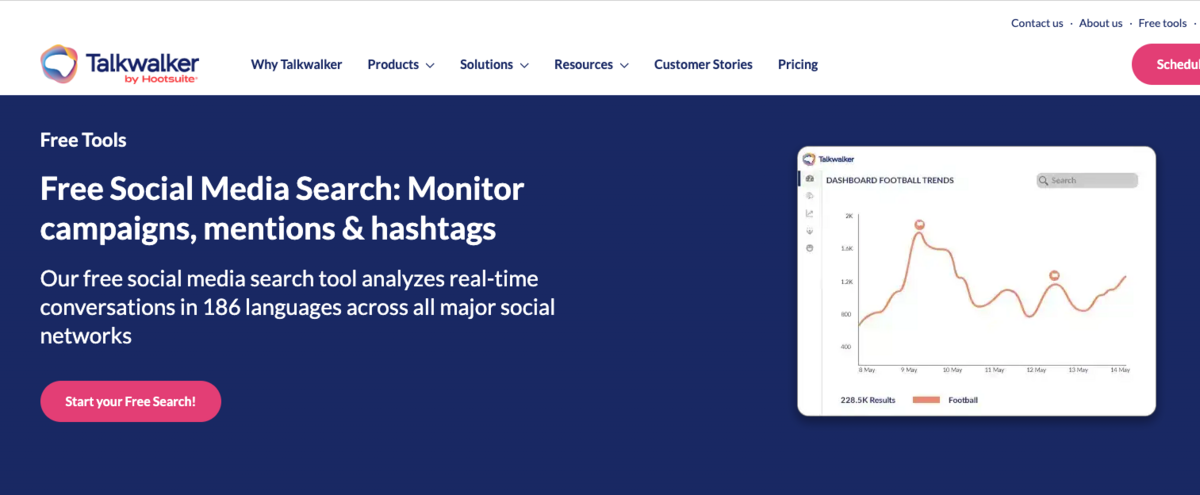
The free version is very limited to just the past few seven days, so I’d definitely recommend upgrading, but you can see the impact here:

Then, to track the impact on site traffic, I compare these mentions with Social traffic on Google Analytics.
It gets a little confusing here so stay with me: Google Analytics calls referral traffic from social media platforms “Organic Social”.
Go to Acquisition>Traffic Acquisition.
Then, I’ll put a secondary dimension of “Session source/medium”.
Last, I’ll search for “referral” traffic in the search bar.
It might look something like this:
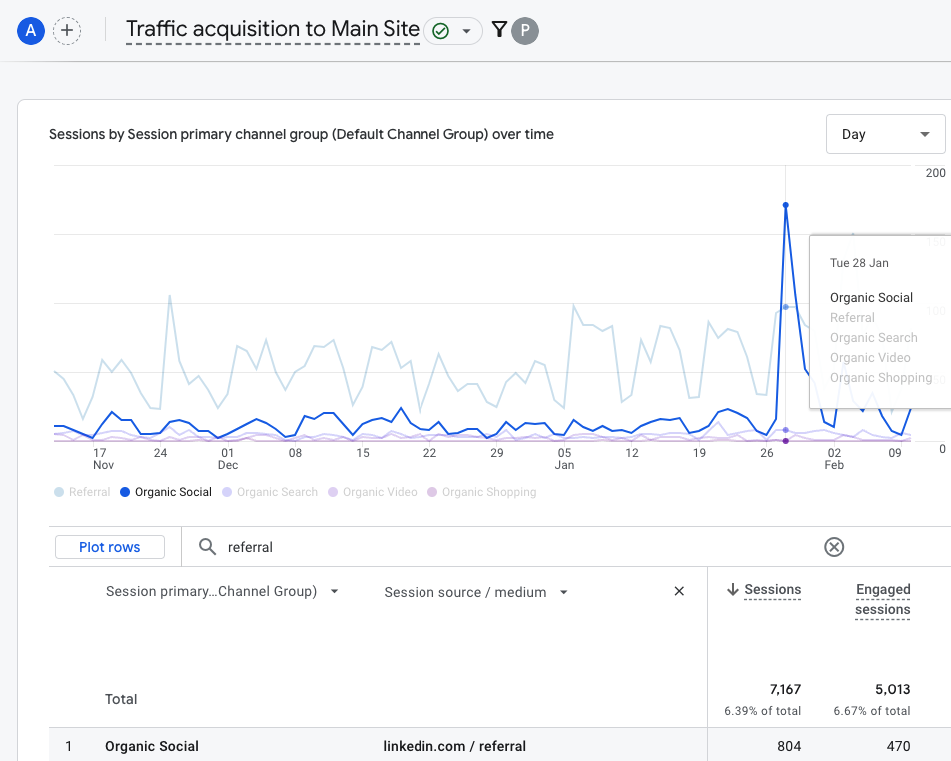
I can tell traffic came from LinkedIn on Jan. 28 (the same day we launched the State of Digital PR post).
If you don’t want to use a tool, you can also measure the impact manually. This takes a lot more time but keeps you in the loop.
For instance, I can go onto LinkedIn and search my brand in the search bar. I select Posts, Top Match, and then go to Past 24 hours.
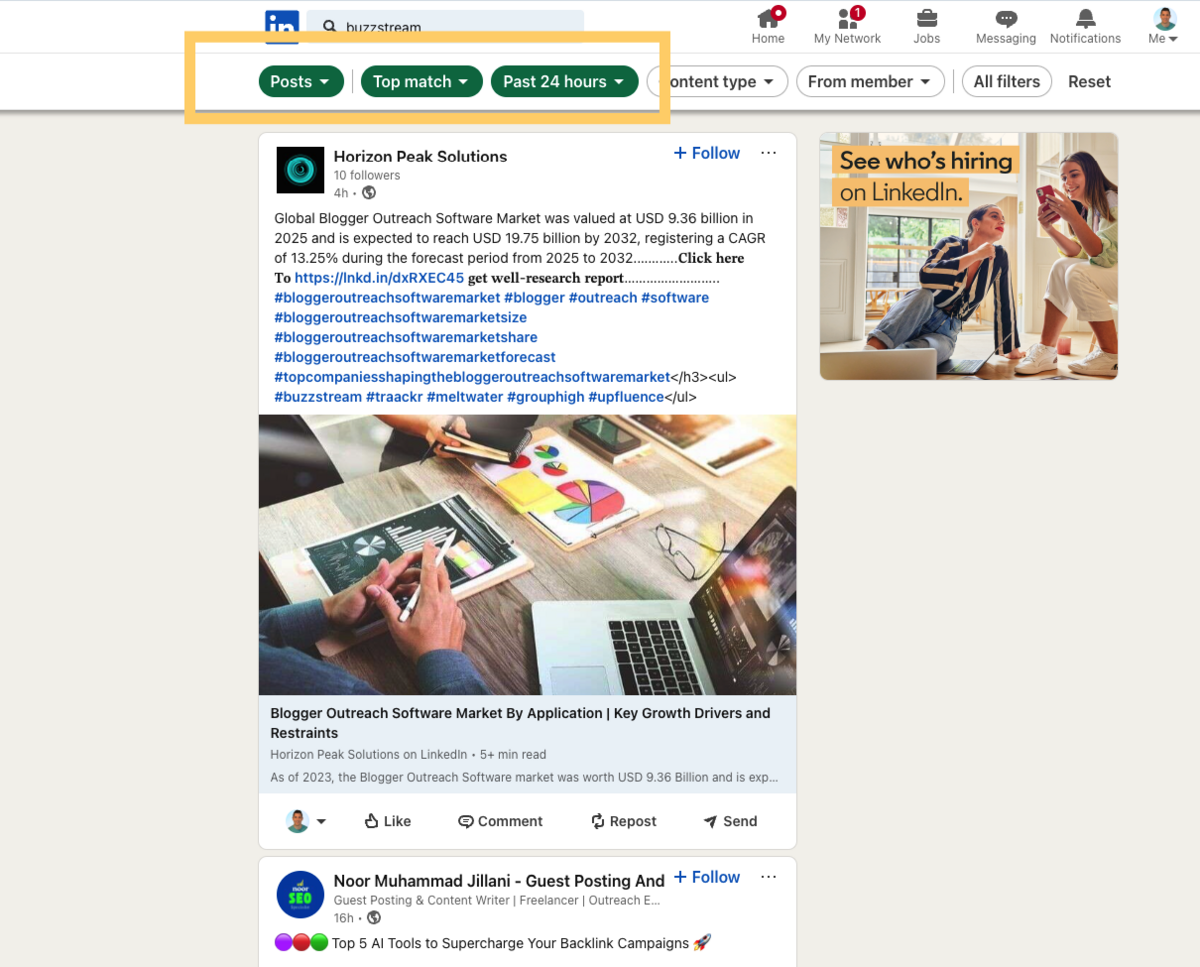
Now, I can see how users are mentioning BuzzStream.
If I wanted to check on BlueSky, I could follow a similar process by popping our name into the search bar:
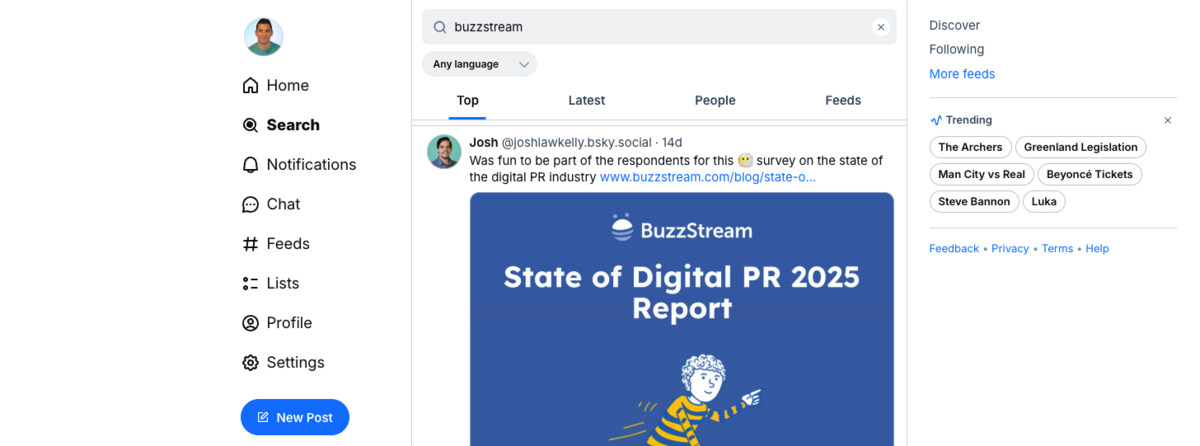
Then, I need to refer back to Google Analytics to see if Organic Social traffic is coming from any of these mentions.
How Long Until You See Impact?
You can see an immediate impact on social media from digital PR if we discuss brand mentions.
For instance, in November 2023, a TikTok user posted a video showing her Stanley drinking mug survived a car. Her post got over 97 MILLION views. (Stanley capitalized on this by sending a response that gave the user a new car!)
Stanley was getting mentioned everywhere online after that (both by PRs and consumers)

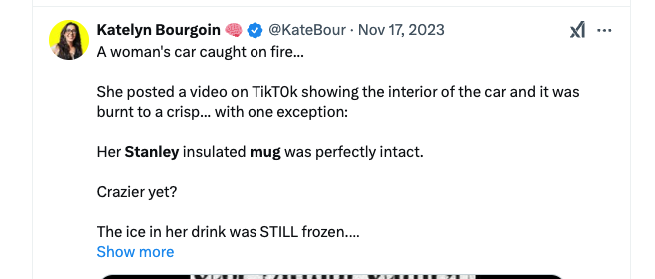
You can see interest in the Stanley brand skyrocketed:
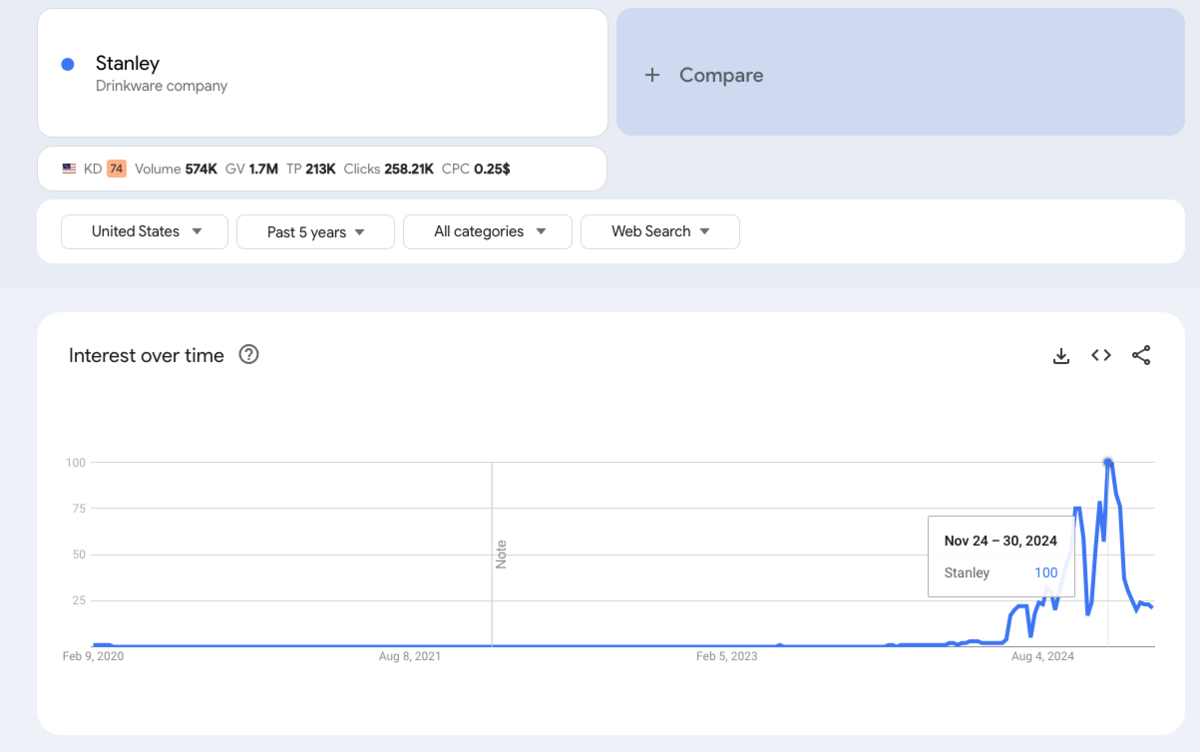
Again, there are a lot of other metrics to consider, like follower growth or sentiment analysis.
In these cases, I like to look at a larger timeframe to gauge the growth over time.
Verdict? There’s no doubt a digital PR hit can cross the boundaries into social media. Just remember that not all social platforms cater to the same demographics.
10. Offline – Radio, TV, Print
Why? While “digital” PR obviously incorporates digital platforms, online campaigns can still impact offline mentions.
In this case I’m mainly talking about offline mentions in radio, TV, and even print magazines.
While this may feel farther off for digital PRs, it can be something you impact, so it’s worth understanding where and how to claim those wins.
What Does It Impact?
Radio, TV, and print mentions can all bring customers to a site.
Although they may feel dated, many markets still rely heavily on radio and print.
For example, a Nielson report shows that as of April 2024, Americans give nearly 70% of their 4 hours of daily listening time to radio (vs 20% to podcasts.)
A strategic local digital PR campaign that gets picked up by radio in a local town can win relevant customers.
How to Track Impact?
Critical Mention is one of the best tools I’ve seen for monitoring offline mentions on radio, TV, and print. Their site says they track over 2,500 TV and radio stations worldwide.
In the main dashboard, you can set up specific programs to watch for or keywords to keep track of.
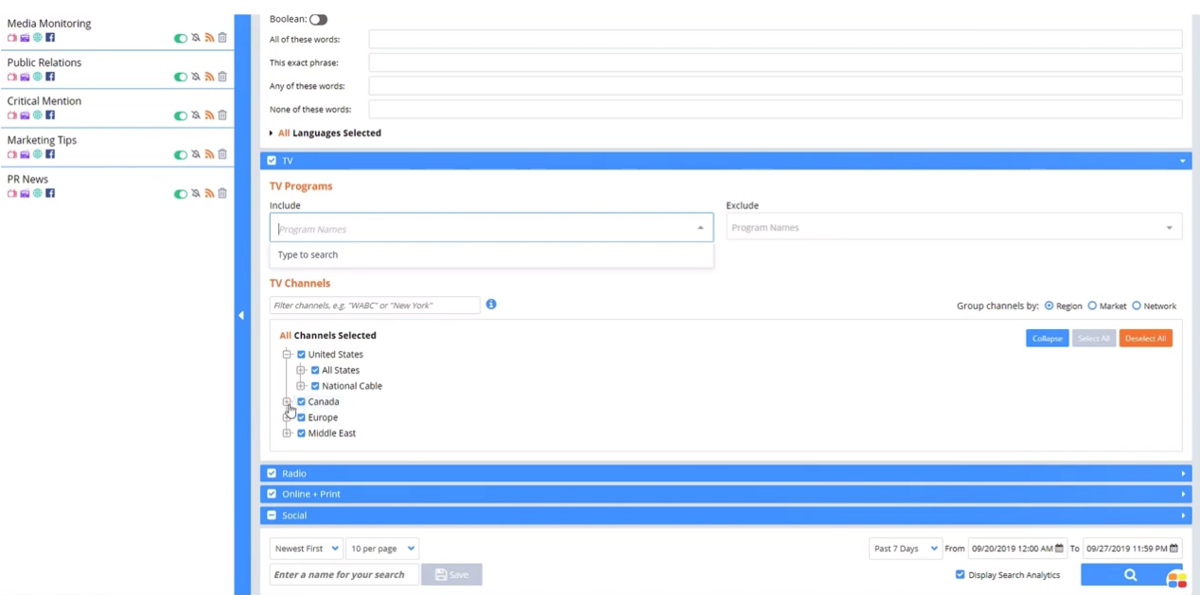
Then you can set up email alerts with trasnscriptions that highlight keywords:
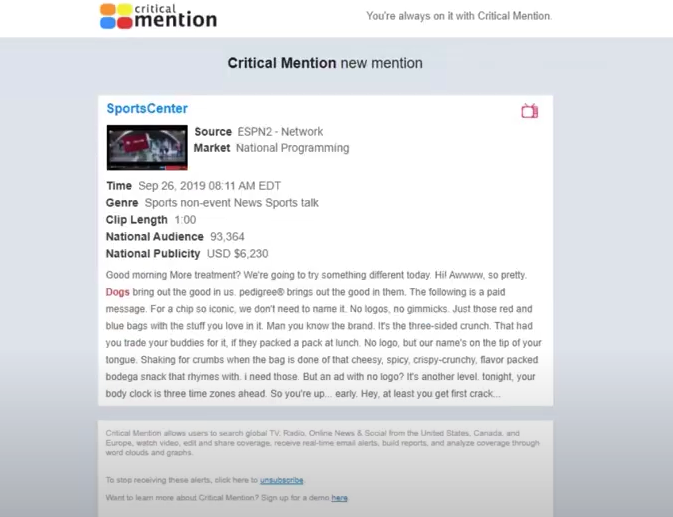
They also have a feature that allows you to edit clips from the coverage:
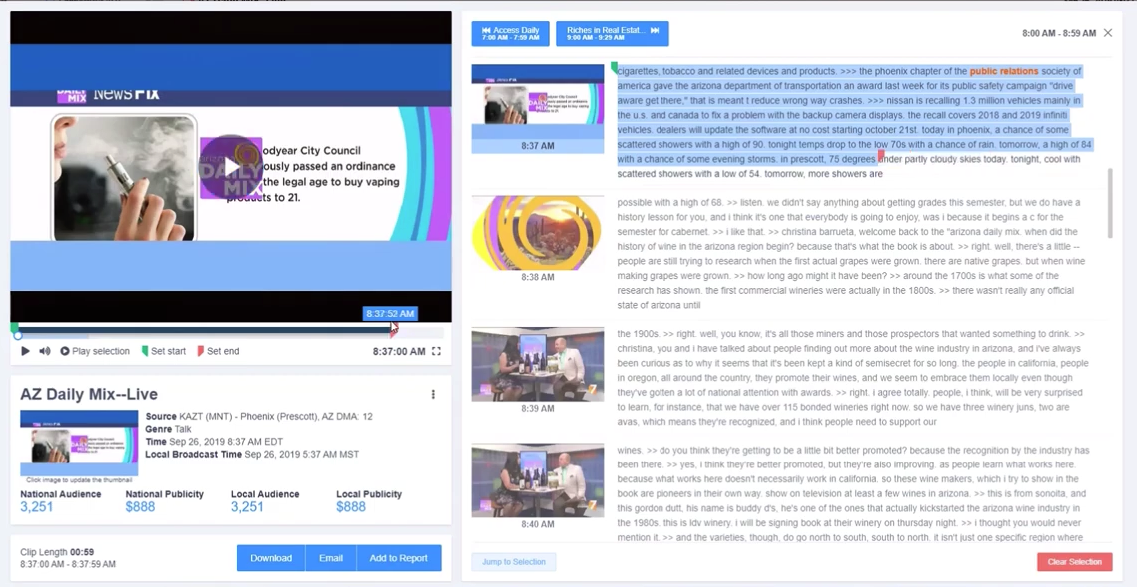
How Long Until You See Impact?
The impact can vary. Sometimes, the effect is immediate. For instance, the Stanley mug car fire story brought television spots, which can prompt users to jump online to visit a website.
Getting a feature in a magazine with a weekly print schedule will obviously take longer to see the impact.
Verdict: Offline mentions are great but are a few steps removed from a digital PR campaign.
11. Owned Audience Growth
Why? Owned audience is a great way to communicate directly with an audience with your trust.
I get the best engagement on my content from our email newsletter subscribers and via social media followers.
Growing the audience on these platforms can be an excellent goal for digital PR campaigns. For this post, I’m talking specifically about:
- Social media followers
- Email newsletter subscribers
- YouTube subscribers
In the next section, let’s examine how and where to track.
What Does it Impact?
Owned audience growth brings more loyal customers who are familiar with your brand.
If they aren’t customers, they are more likely to become ones.
If they are already customers, they can become unofficial brand ambassadors.
How to Track Impact?
There are different tools that help you track follower growth, but one I found that tracks multiple at once is NapoleonCat.
I can link up pretty much all of our social channels to keep an eye on social growth.
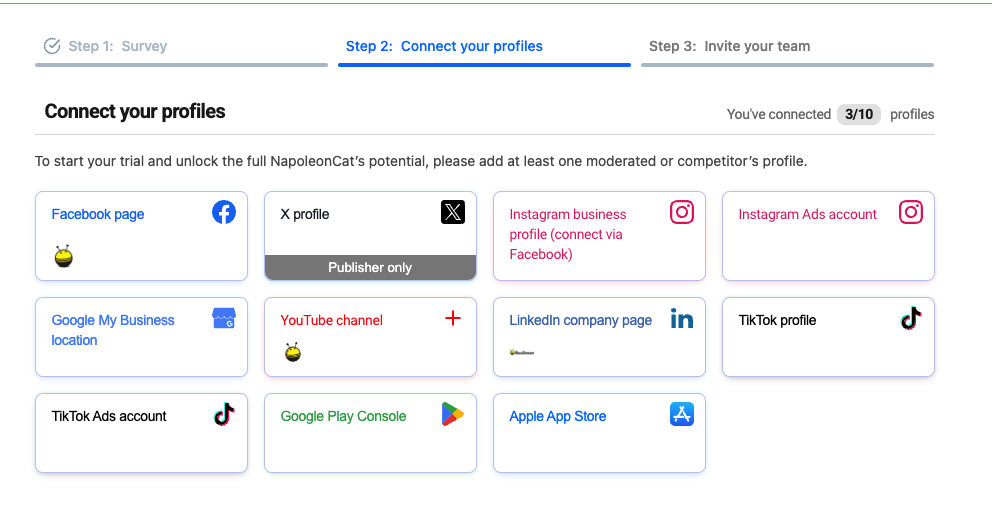
I can also manually track most platforms.
For instance, I’ll go to my LinkedIn Dashboard if I want to track the campaigns that drive LinkedIn followers.
Then I’ll select the Audience tab and I can toggle the date to show the previous year:
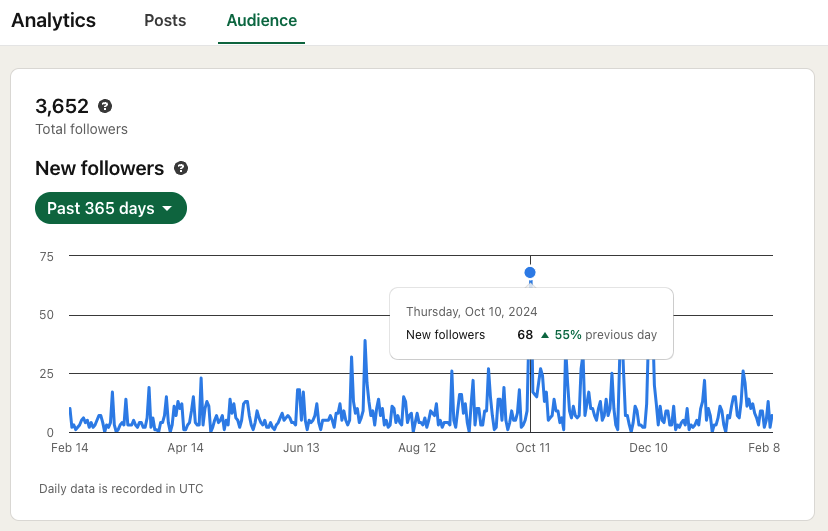
I see that I had a considerable boost on October 10, 2024.
Looking back at my posts, this coincided with a link building statistics campaign that I posted about on LinkedIn:
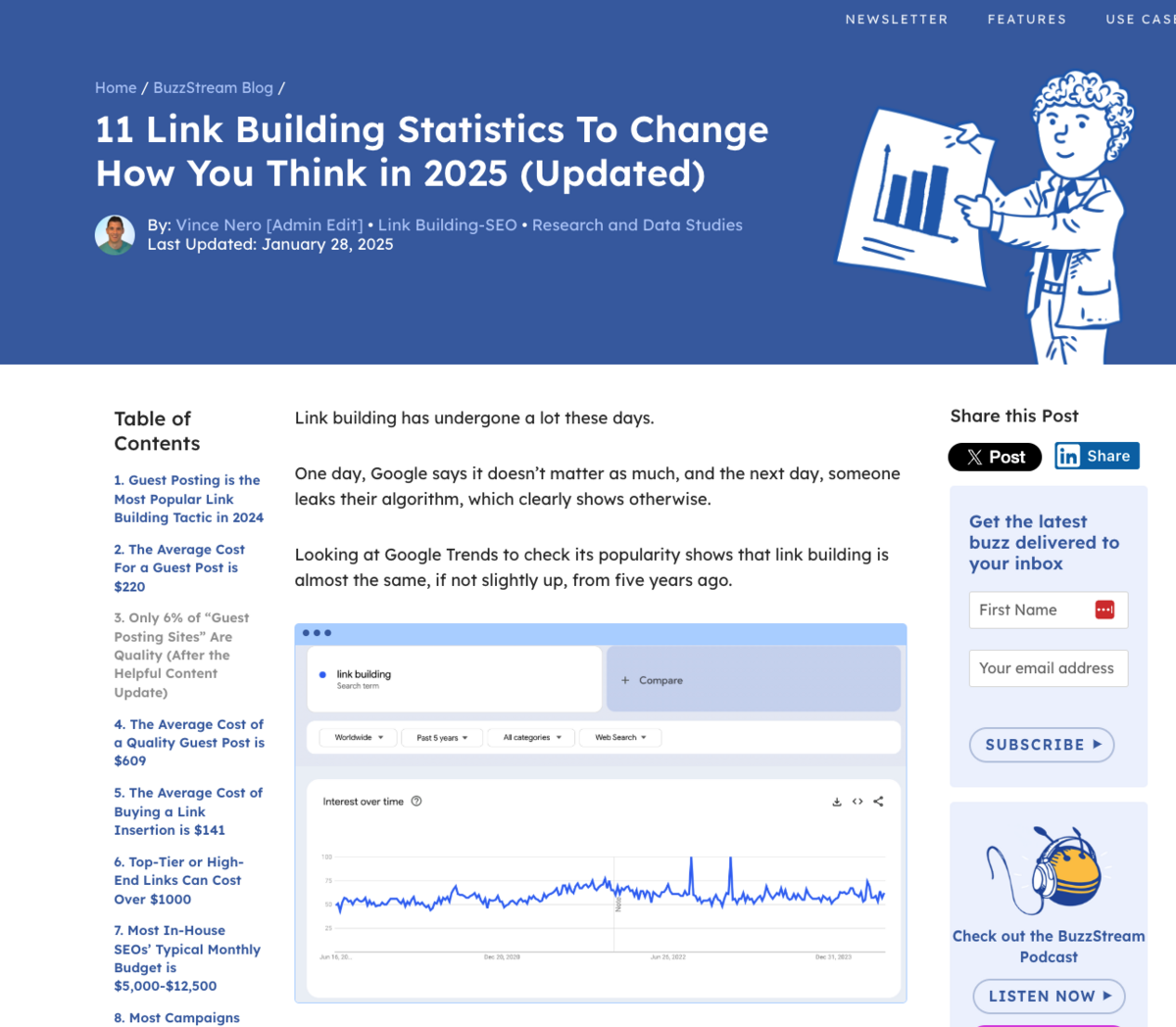
As you can see, campaigns can impact owned audience growth if you know where to look.
How Long Until You See Impact?
An owned audience can grow from digital PR campaigns very quickly after publishing. But, it does depend on where and how the campaigns get distributed.
Verdict: Owned audience growth can be a great extra metric to point to but is rarely the main KPI of a digital PR campaign.
12. Leads and Sales
Why? The ultimate goal for most/if not all marketing is converting to sales or leads.
Typically, the most newsworthy content is not the kind that converts the best.
As we saw from our State of Digital PR post, only a quarter of PRs think it’s effective for driving leads, and even less for increasing sales (18.5%):
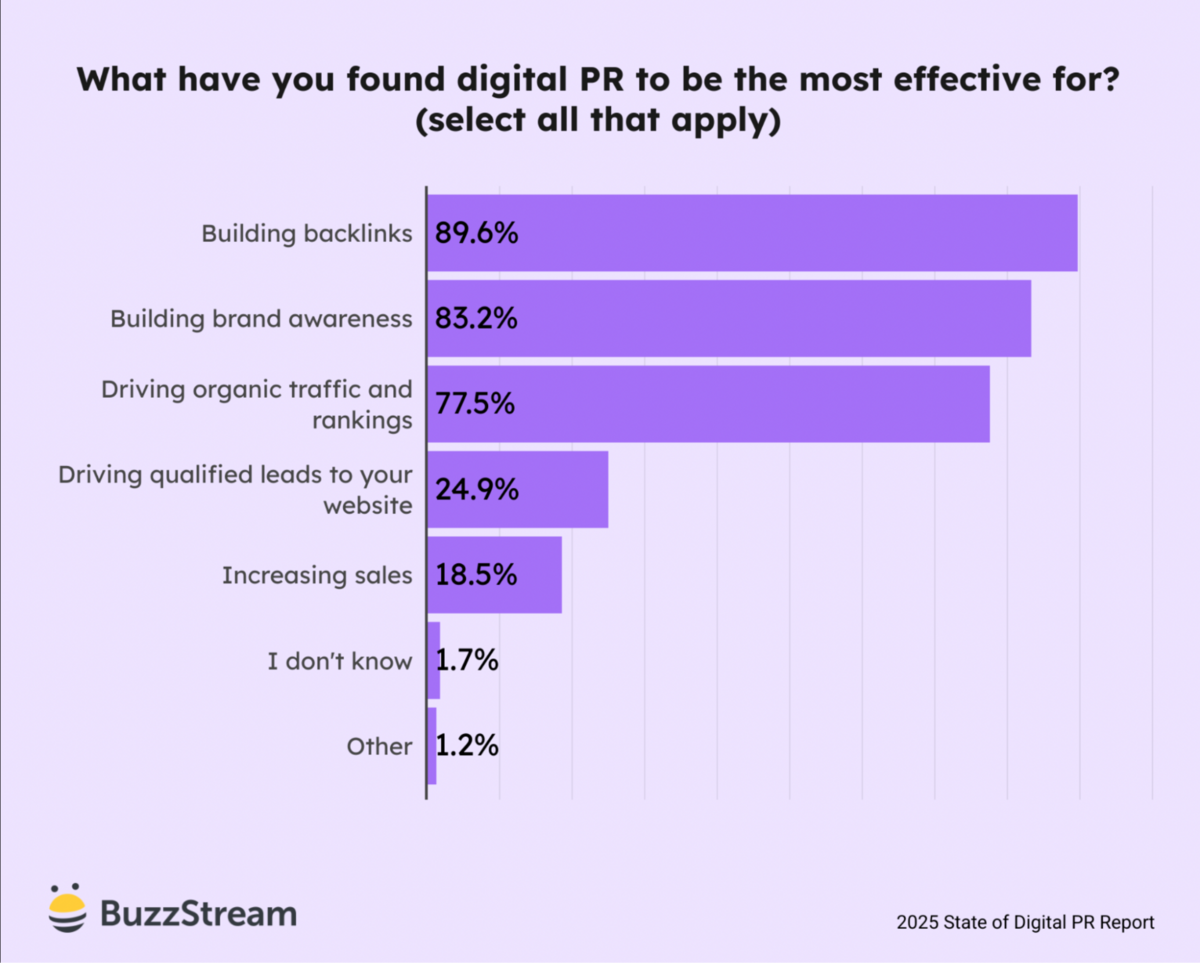
As Senior Digital PR & Influencer Marketing Specialist at KURU Footwear, Victoria Schmid, told us in our podcast discussion about in-house digital PR, if you try to relate your campaigns too closely to your product, they may come off as too salesy—especially for ecommerce brands.
However, if you can relate a campaign to a boost in sales, you’re that much more likely to get a thumbs up from the C-Suite.
What Does it Impact?
Obviously, sales impact the bottom line.
So, as digital PRs, sales can make or break relationships/contracts with clients and stakeholders.
How to Track Impact?
The best way to measure conversions is to ensure that your analytics platform has proper event tracking set up.
The most common way to measure is through event tracking in Google Analytics 4.
To create an event, go to Admin>Data Display>Events.
Then, choose Create Event.
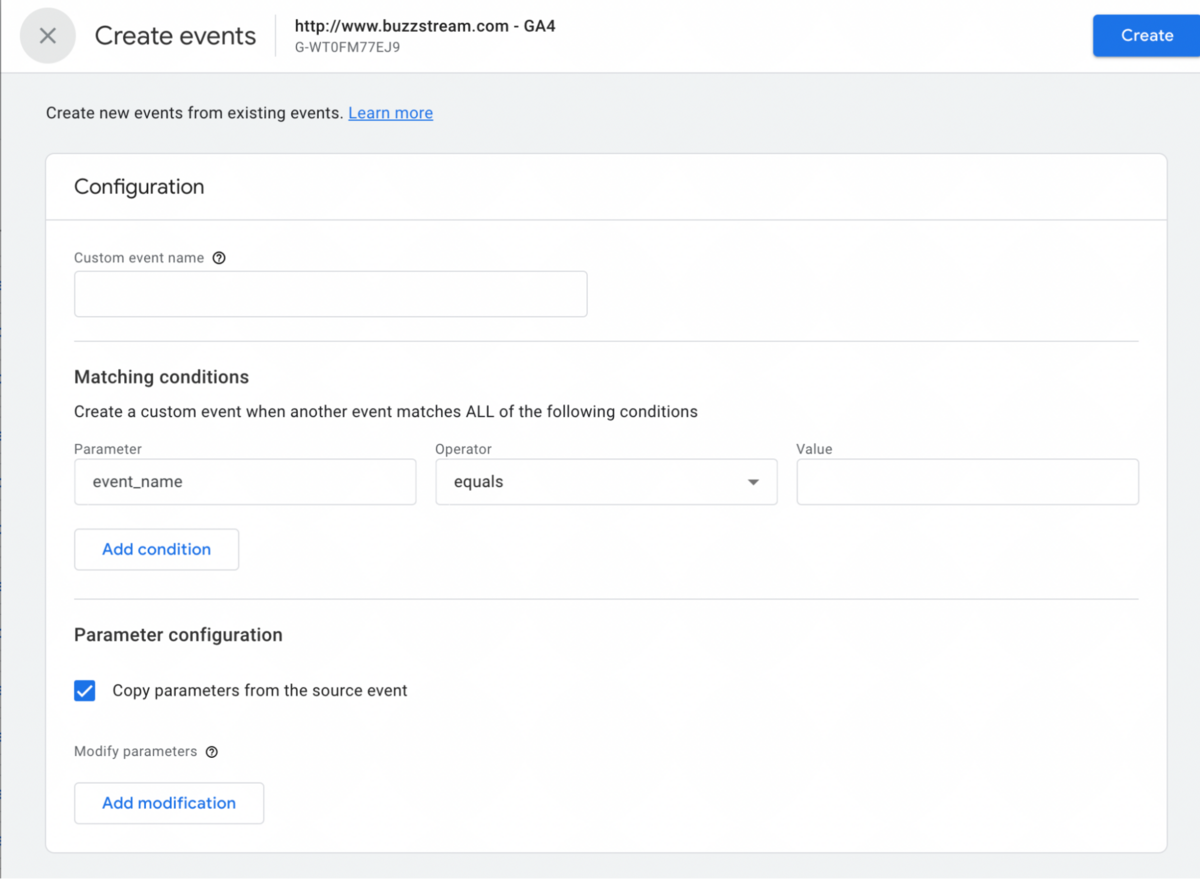
Now, I’ll add any Matching conditions for a conversion event I want to track.
For instance, I like to track what content leads users to our plans-pricing page. So, my event looks like this:
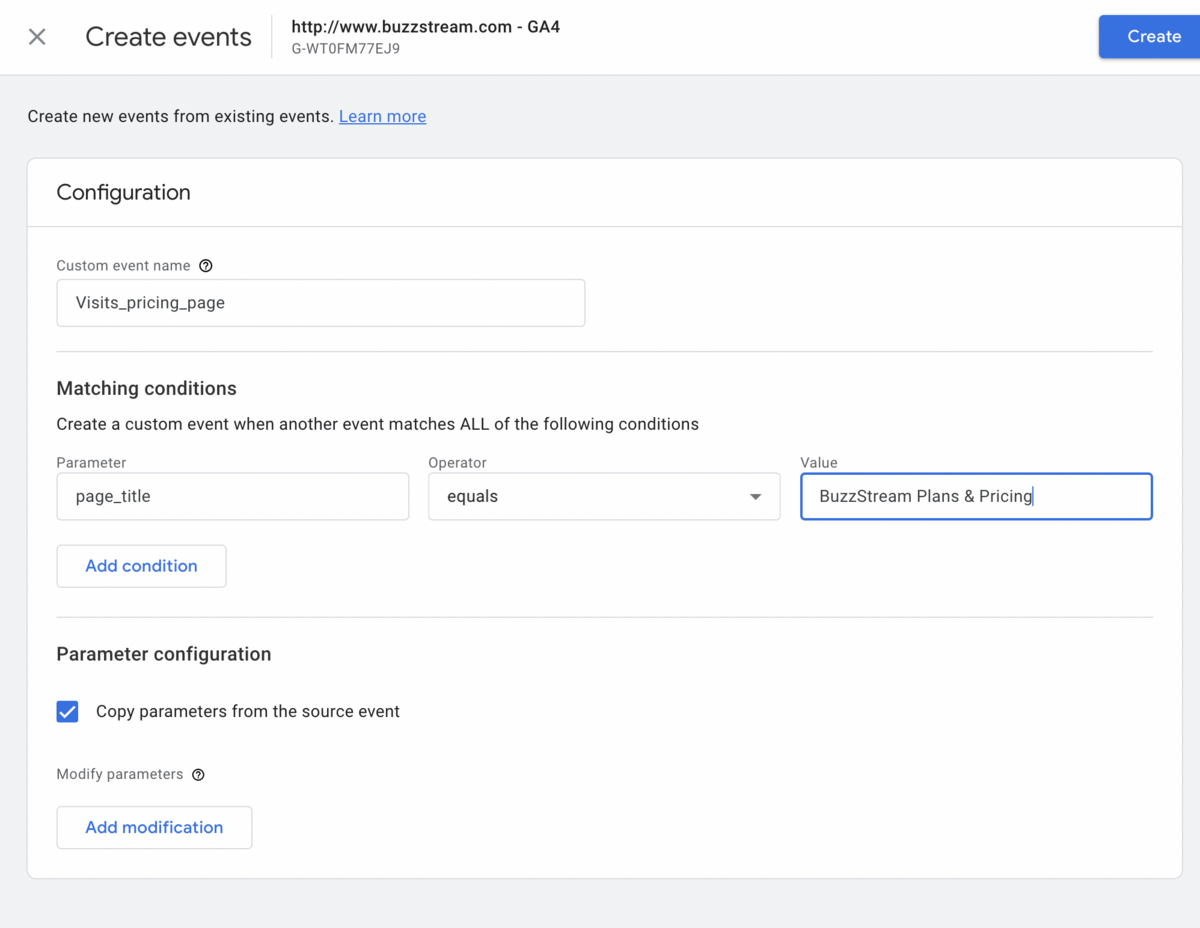
I can then go to Key Events and toggle this event as a Key Event.

(We have many custom events set up from the back end that track users who successfully signed up for our tool, but that takes some dev work.)
Now that I have that event set up, I can track conversions from specific pages or traffic sources.
To track leads from a specific page, I go to Engagement>Landing Page to see the traffic driving them.
I can select the event under Key Events and see which landing pages drive leads.
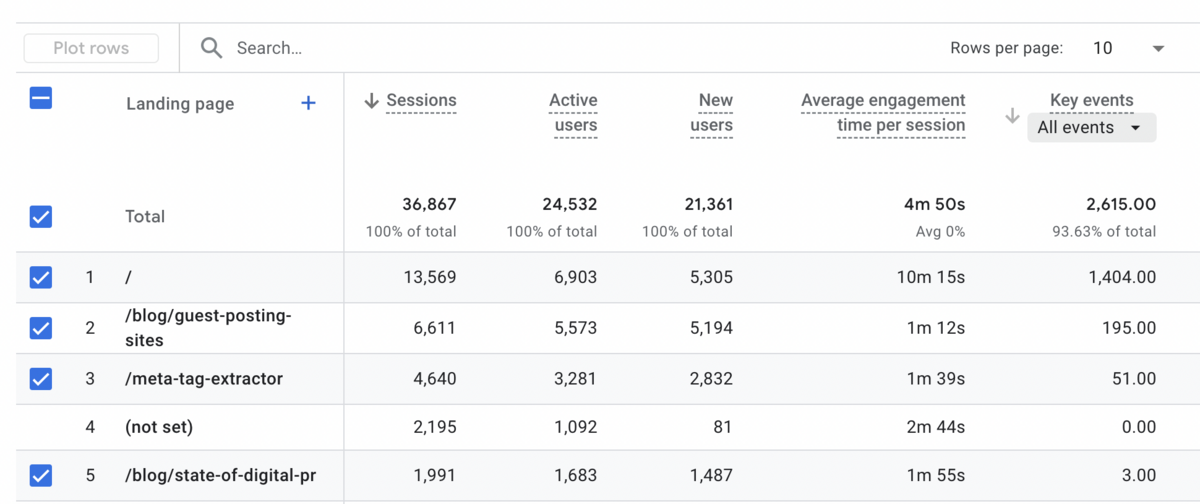
For instance, the State of Digital PR post has driving 3 leads in the past month.
To track from a specific traffic source, I can go to Reports>Acquisition>Traffic Acquisition and then look at the channel group that is sending the most events.
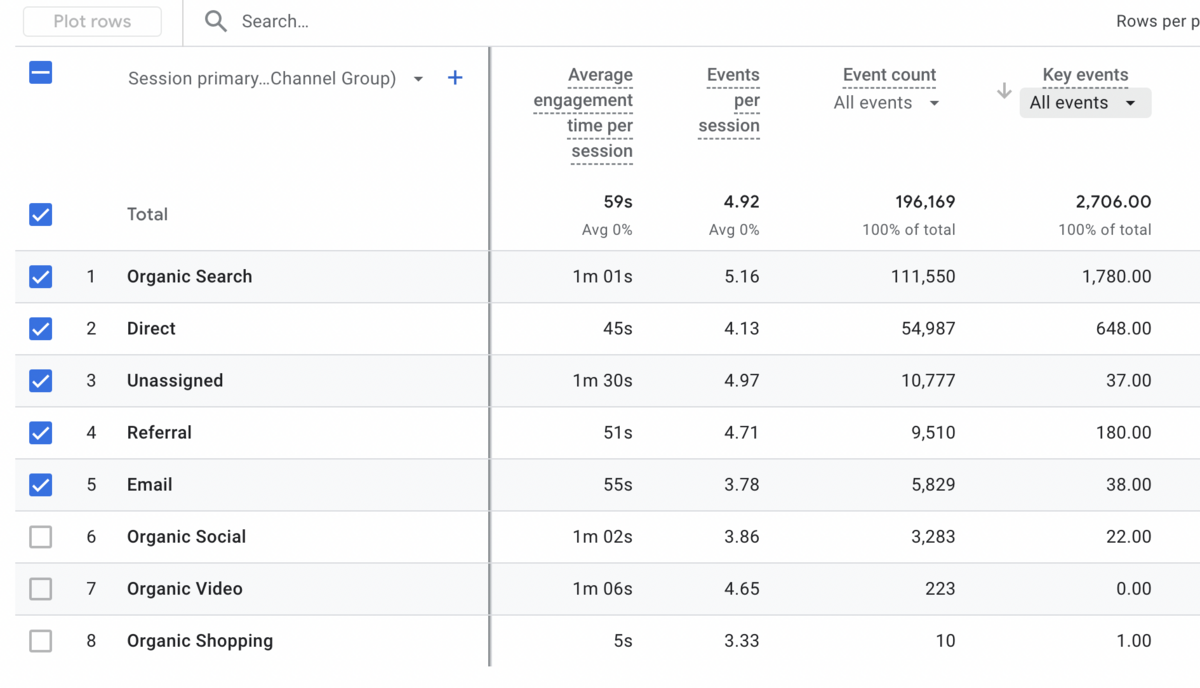
This gives a better understanding of how each channel drives leads and conversions.
How Long Until You See Impact?
If your campaign is more bottom-funnel, leads and sales can immediately occur. But your content needs to sync with your target audience.
For instance, our State of Digital PR post isn’t meant to be a lead generation campaign. It’s more about generating links, driving interest on social media, and providing value for our users.
And you saw from our analytics snapshot that it’s not a significant lead driver.
The kind of digital PR campaigns that tend to convert into leads are things like tools or calculators.
These are assets where your brand or site is the logical next step after the digital PR campaign.
For example, Dossier’s “fragrance quiz” helps users find their perfect scent.

The quiz has almost 50 unique referring domains that link to the quiz:

However, some really creative PRs are creating excellent campaigns that impact all areas of a site.
If your campaign helps build links to increase rankings to key pages, leads and sales can increase in about six months to a year.
This is the more macro look that I’ve been talking about throughout the post.
However, for this to work, your content needs to properly funnel link equity to the key pages. This means ensuring your site follows SEO best practices.
Verdict: While digital PR isn’t the natural goal for PR, the more PR efforts can get linked to the bottom line, the more buy-in you’ll get from clients and stakeholders.
Digital PR Shouldn’t Be Just a Numbers Game
No matter what Google does, clients and stakeholders will still be wowed by large numbers.
Yet, we are moving further away from the large-scale link building that dominated the first few decades of 2000.
PRs and SEOs, instead of raw link counts, showcase the broader media impact, traffic gains, and brand exposure.
Showcase the ways you are getting the right coverage from the right places.

 End-to-end outreach workflow
End-to-end outreach workflow



 Check out the BuzzStream Podcast
Check out the BuzzStream Podcast





